Illustration is in vogue
Clothes and accessories illustrated in the Bocconi and Rinascente catalogues

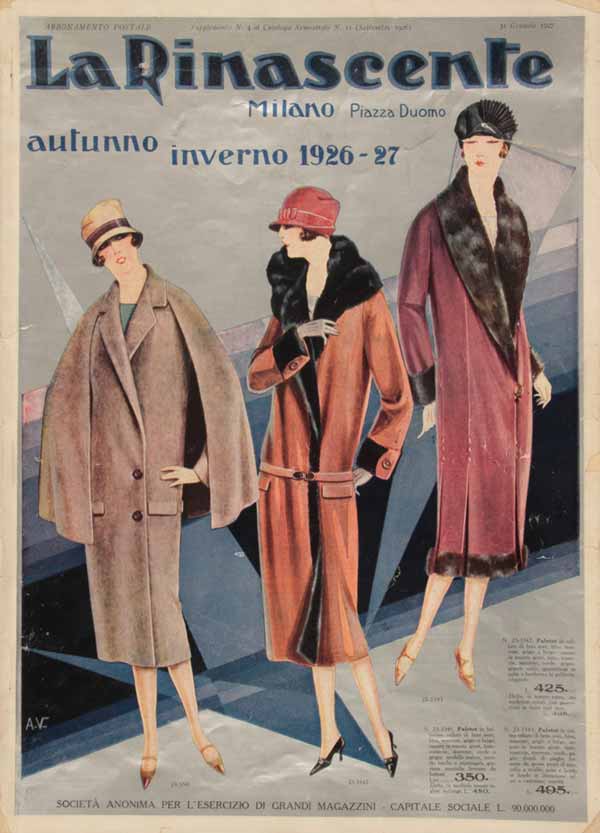
1 / 2 — la Rinascente, autunno-inverno 1926-27, supplemento n. 4 al catalogo semestrale n. 11, Milano, 31 gennaio 1927, copertina e quarta di copertina
Civica Raccolta delle Stampe Achille Bertarelli, Milano
The history of fashion illustration is closely intertwined with that of women’s publishing and, like magazines, department store catalogues also represent a valuable source of material for study of this area. From the outset, department stores understood the effectiveness of illustration as a means of communication, using it to present and advertise their products. As the stores focused mainly on fashion in its many forms (including fabrics, clothing, linen and accessories), the pages of their catalogues were brimming with extraordinary fashion illustrations.
First the Bocconi brothers, and then Rinascente, invested a considerable amount of time and economic resources to this type of marketing. Indeed, fashion illustration was a constant, if not the main, feature in all their sales catalogues from the 1800s to the 1940s, when the pages began to feature photographs over illustrations.
Leafing through the Bocconi brothers’ catalogues from 1875 to 1905, and those of Rinascente from 1923 to 1940, the development of Italian fashion drawings over the years, in terms of style, composition and communication, can be traced.
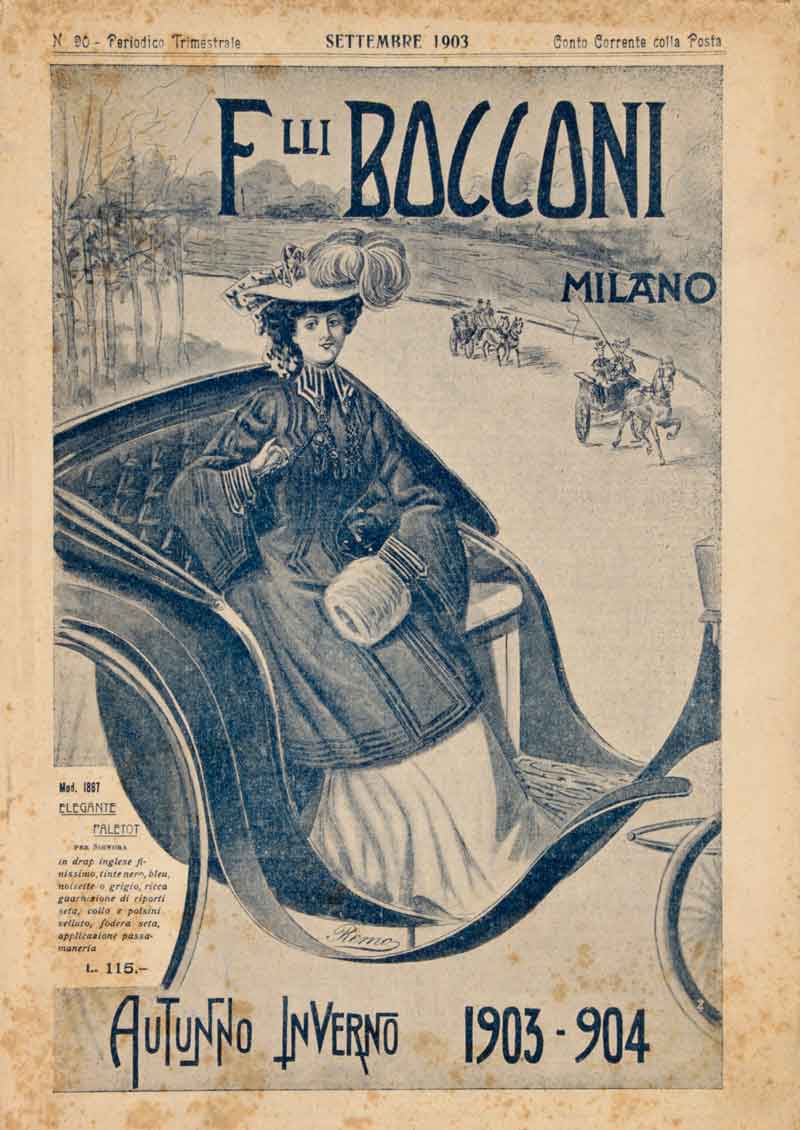
3 — Fratelli Bocconi Milano. Autunno Inverno 1903-04, periodico trimestrale, n. 90, Milano, settembre 1903, copertina
Civica Raccolta delle Stampe Achille Bertarelli, Milano

4 — la Rinascente. Novità d'autunno, listino mensile, n. 10, Milano, 6 ottobre 1938, copertina
Civica Raccolta delle Stampe Achille Bertarelli, Milano
The Bocconi Store fashion illustrations
In the 1800s, fashion publishing took off, with new publications appearing all over Europe. Increasingly advanced technologies were being developed, including in the field of image reproduction, allowing all magazines to use illustrations inside rather than simply as an insert like before. In Italy, Milan was the biggest publishing hub not only of fashion magazines but of printed illustrations in general.
From the very beginning, when their main product was still tailored menswear and before they expanded and moved their shop to the old Hotel Confortable premises, the Bocconi brothers decided to promote their store with illustrated publications that were handed out free of charge to customers. The first example that we know of is the publication with the revealing title ‘Figurino della moda’ (‘Fashion Sketch’) which was in its fourth year in July 1875. Among the pages of Milanese news and information about the history of customs, the Bocconi brothers also dedicated pages to their ready-to-wear clothing. They were mainly pages completely filled with text, with just a few basic illustrations.
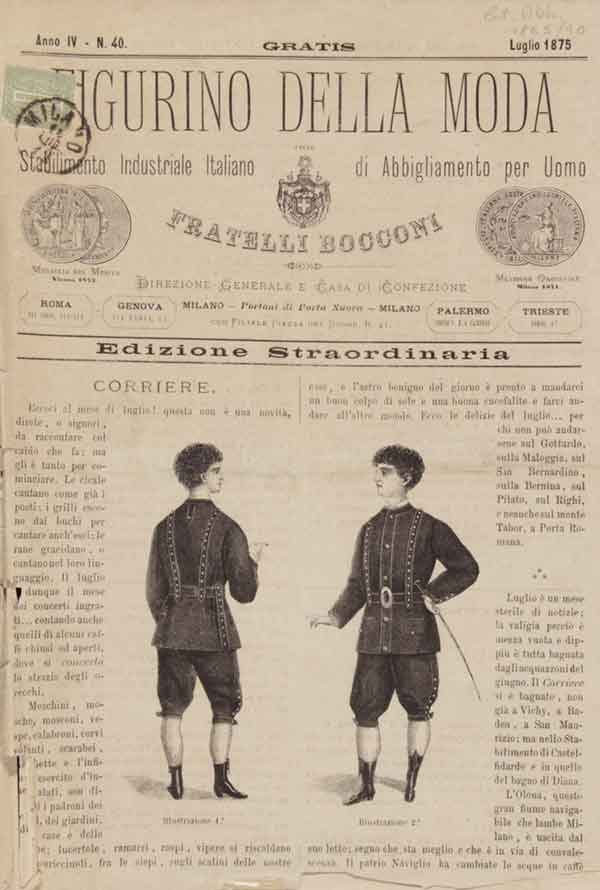

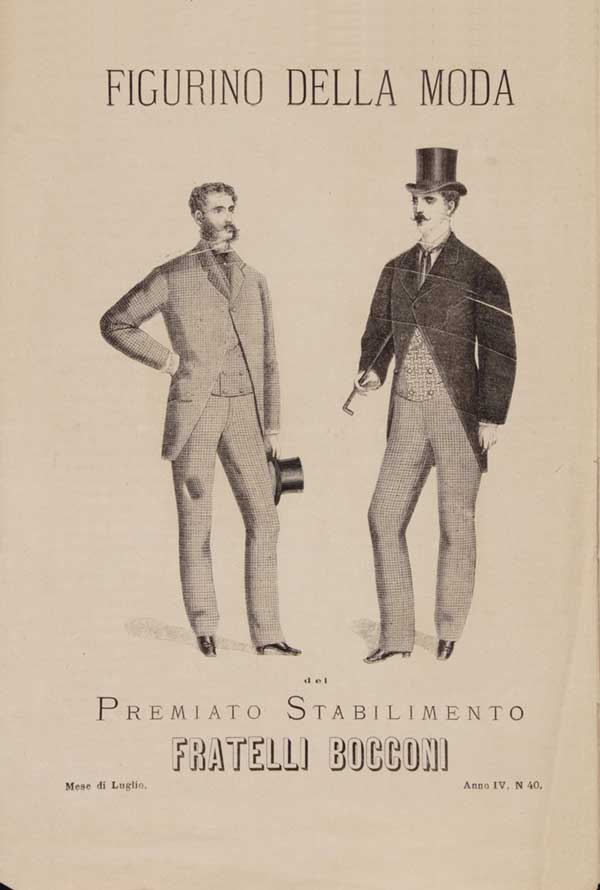
5 / 6 / 7 — Figurino della moda, a. IV, n. 40, Milano, luglio 1875, copertina, pagina interna e quarta di copertina
Civica Raccolta delle Stampe Achille Bertarelli, Milano
Having transformed their factory into the department store Alle Città d’Italia, the Bocconi brothers started to regularly publish mail order catalogues, filled with beautiful illustrations. The most important issues were the ‘Album delle Novità’, the so-called ‘Latest product albums’, which were released just before the Spring-Summer and Autumn-Winter seasons to promote the new collections. The other editions were special catalogues devoted to linens, Christmas gifts and other specific product lines.

8 — Album delle Novità dei Grandi Magazzini Alle Città d'Italia, Estate 1887, periodico trimestrale, a. X, n. 30, Milano, 1887, copertina
Civica Raccolta delle Stampe Achille Bertarelli, Milano

9 — Grandiosi Magazzini di Novità Aux Villes d'Italie. Annuale e Grande Esposizione, Biancheria, catalogo speciale di biancheria, Milano, 1880, copertina
Civica Raccolta delle Stampe Achille Bertarelli, Milano
The Milan catalogues were also sent to customers outside the city, and later throughout Italy. They were intended to promote products that could be found in stores, and particularly to allow for mail order purchases to be made, in order to increase sales. The catalogues used the same formula as the stores – lots of items were shown, creating the same sense of opulence and visual theatricality that customers enjoyed when entering the department store, encouraging them to buy their wares.
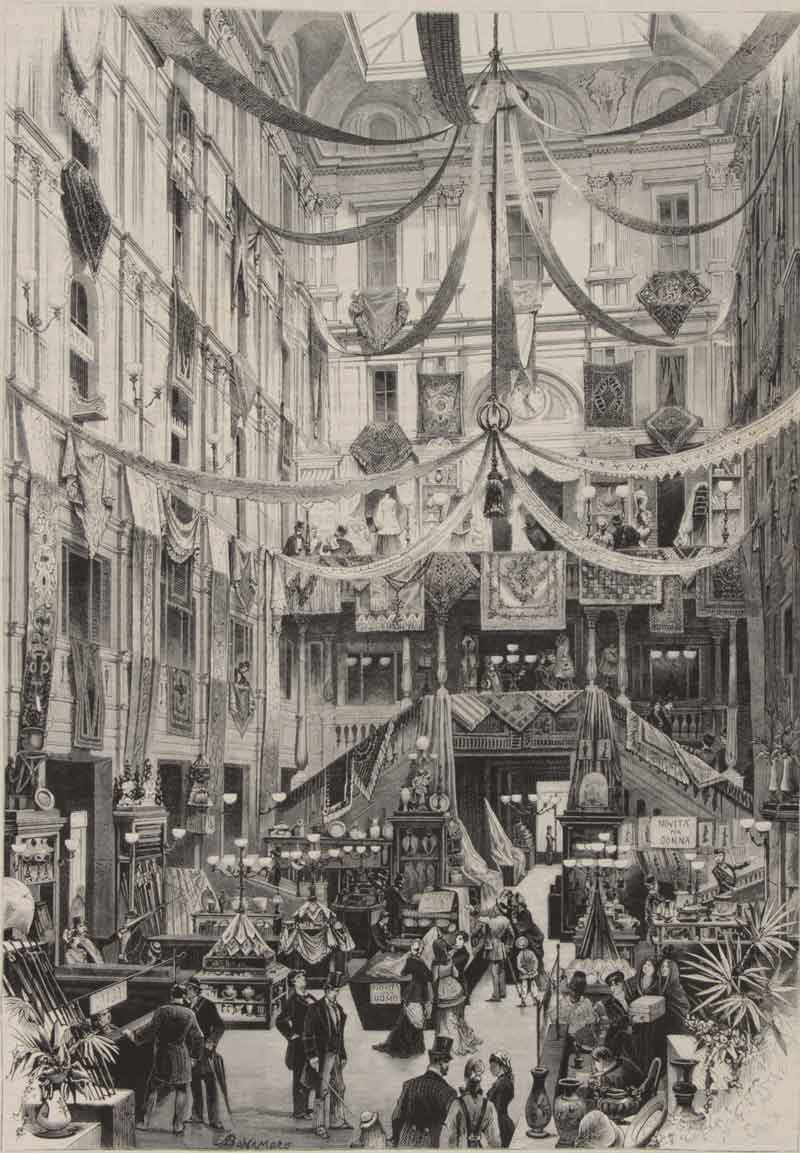
10 — Bonamore, Interno dei magazzini dei Fratelli Bocconi “Aux Villes d’Italie”, in “Illustrazione Italiana”, a. VI, n. 17, 27 aprile 1879, p. 265
Civica Raccolta delle Stampe Achille Bertarelli, Milano
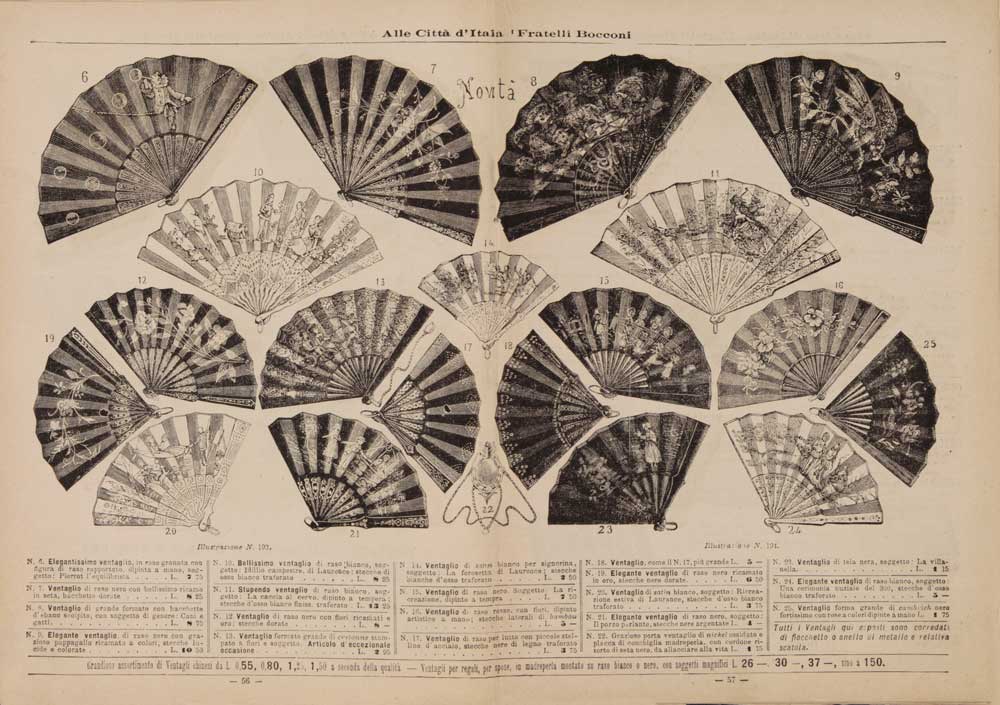
11 — Album Novità, Primavera-Estate 1883, periodico bimestrale, Milano, 1883, pp. 56-57
Civica Raccolta delle Stampe Achille Bertarelli, Milano
The illustrations became an integral part of each page, with carefully-studied layouts for a clever interplay of text and pictures – illustrations took centre stage, gradually becoming bigger and bigger to take up all the available space.
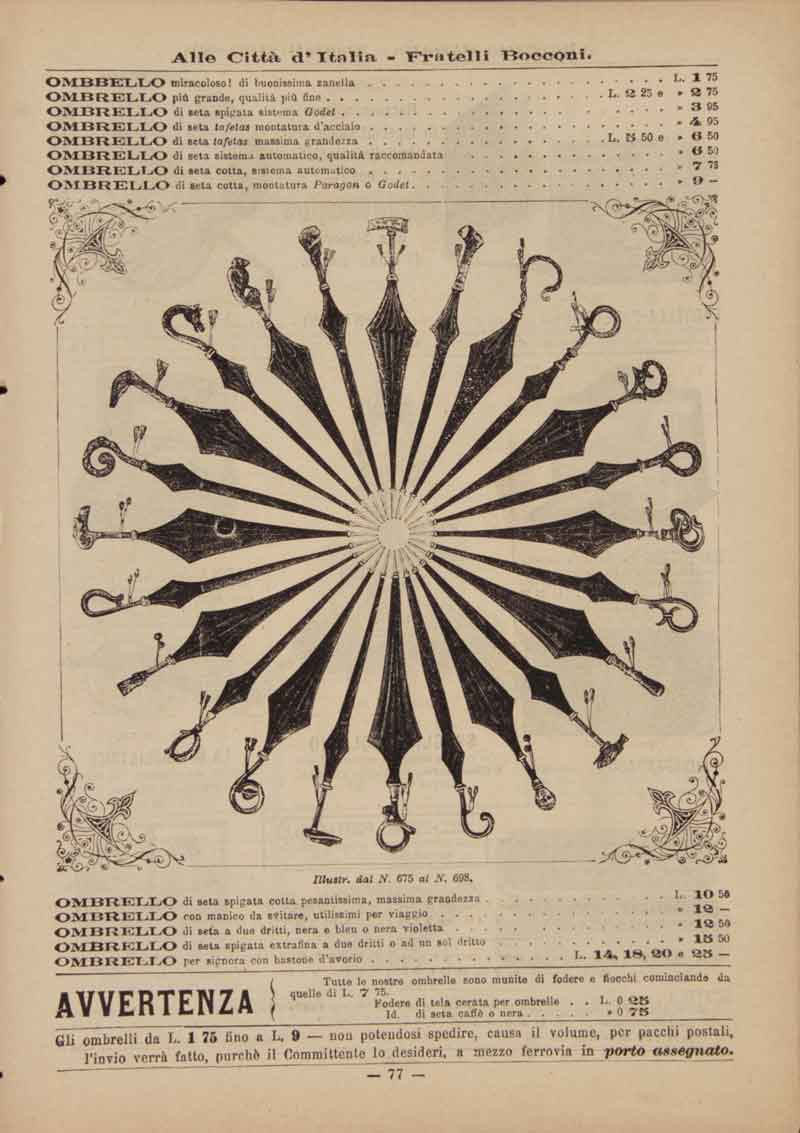
12 — Album delle Novità dei Grandi Magazzini Alle Città d'Italia, Estate 1887, periodico trimestrale, a. X, n. 30, Milano, 1887, p. 77
Civica Raccolta delle Stampe Achille Bertarelli, Milano
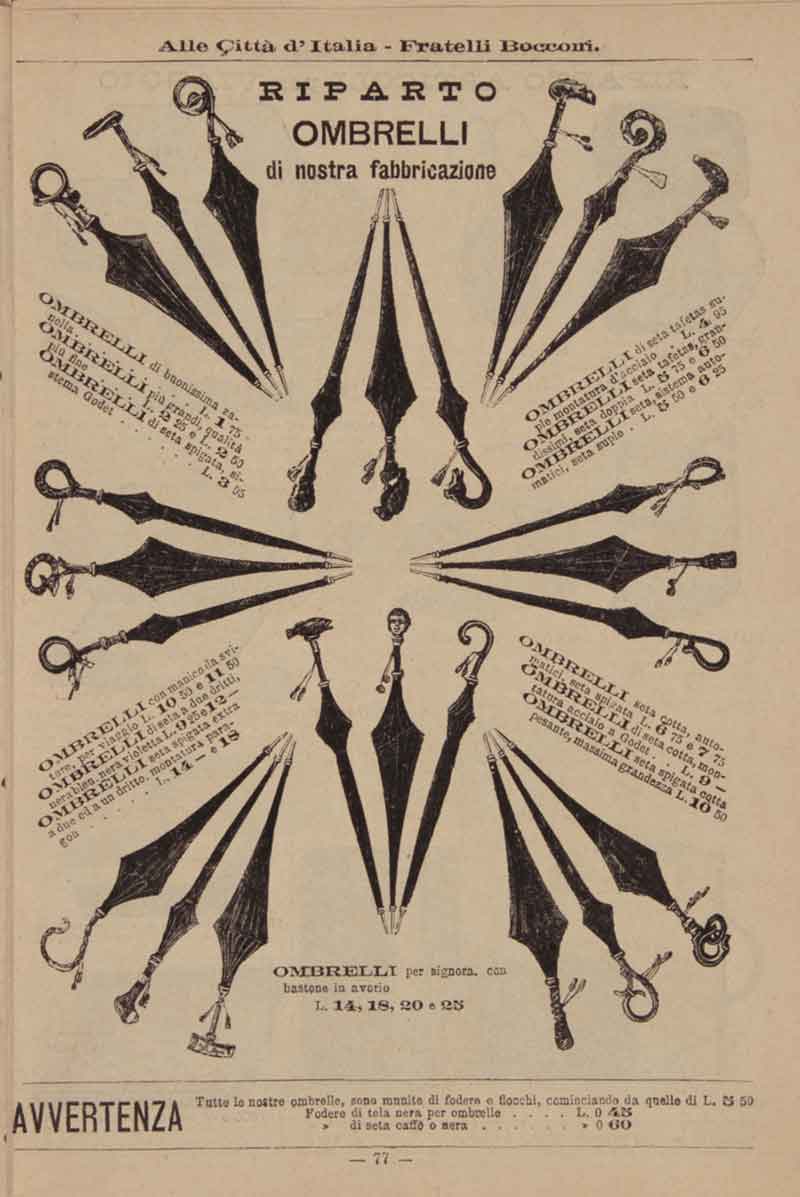
13 — Album delle Novità dei Grandi Magazzini Alle Città d'Italia, Inverno 1888-89, periodico, Milano, 1888, p. 77
Civica Raccolta delle Stampe Achille Bertarelli, Milano
During the 1880s, the catalogues were adorned with pictures, reducing written text to a mere description of the item, becoming illustrated throughout to increasingly resemble fashion magazines. Similarly, the inside pages were in black and white, while the covers started to feature colour illustrations.

14 — Album delle Novità dei Grandi Magazzini Alle Città d'Italia, Estate 1887, periodico trimestrale, a. X, n. 30, Milano, 1887, p. 6
Civica Raccolta delle Stampe Achille Bertarelli, Milano
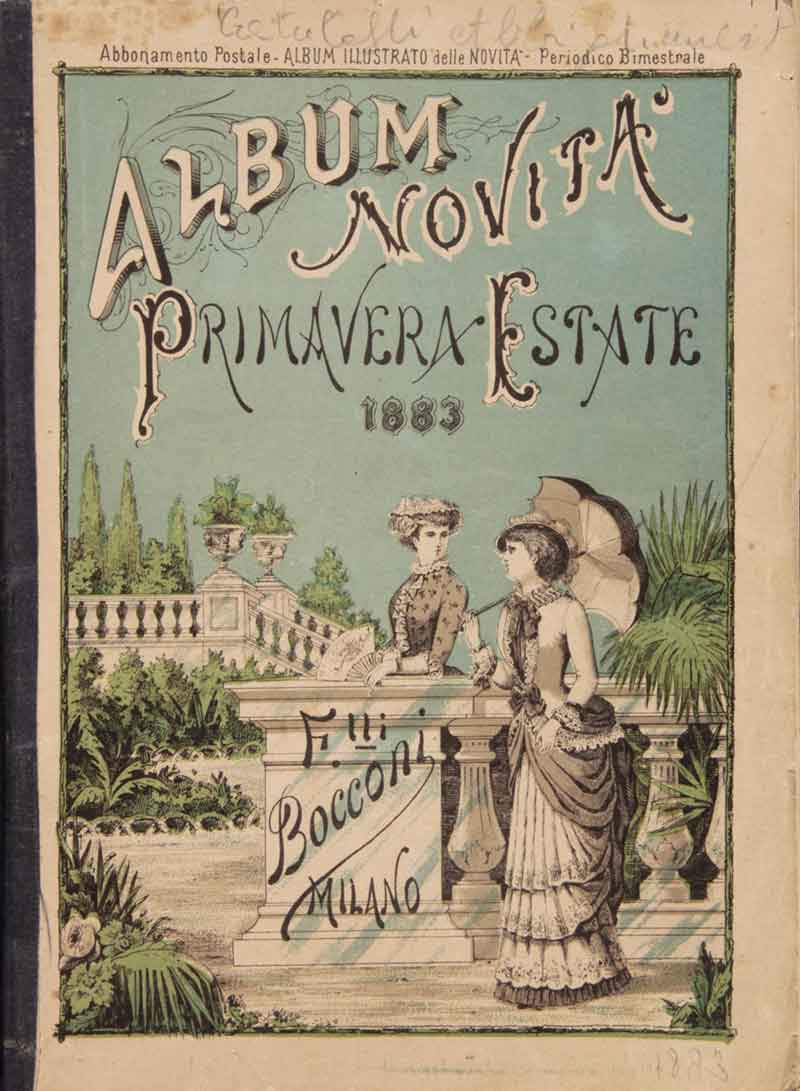
15 — Album Novità, Primavera-Estate 1883, periodico bimestrale, Milano, 1883, copertina
Civica Raccolta delle Stampe Achille Bertarelli, Milano
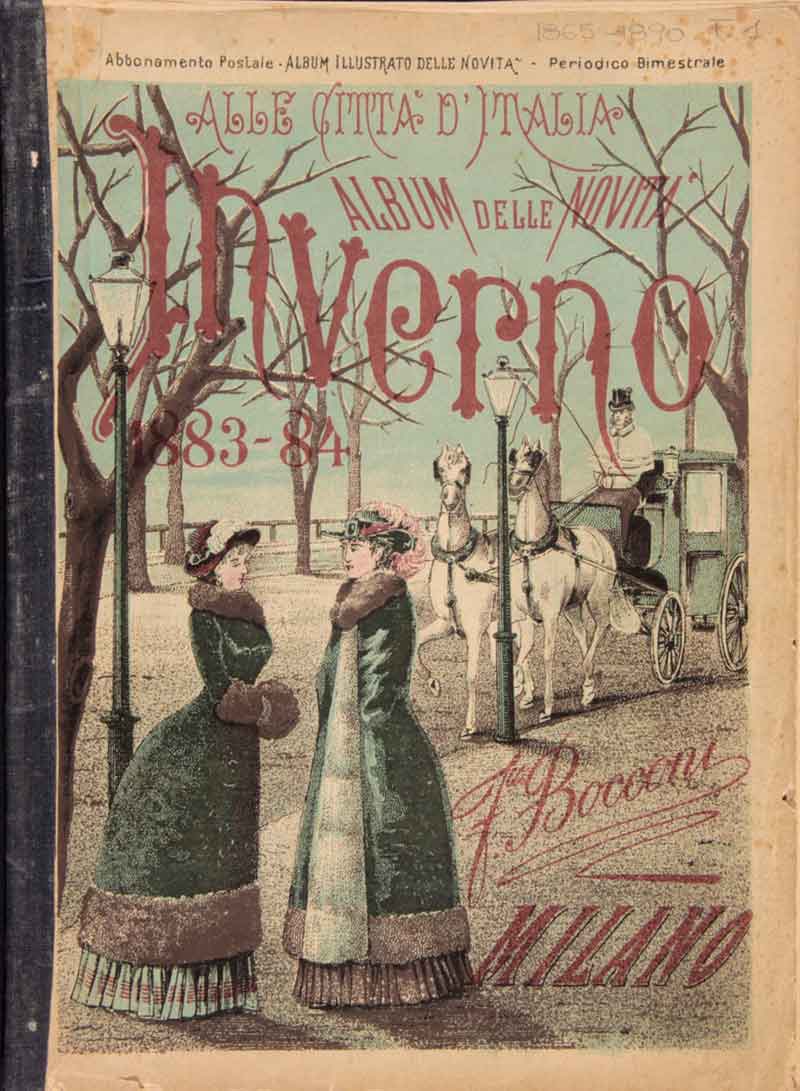
16 — Album delle Novità, Inverno 1883-84, periodico bimestrale, Milano, 1883, copertina
Civica Raccolta delle Stampe Achille Bertarelli, Milano
The preface on the second page of the ‘Album delle Novità’ from summer 1887 is meaningful in understanding the focus placed on publishing each and every catalogue, and the growing importance afforded to the illustrations: “Our distinguished customers will not fail to notice how much attention we pay to the creation of our catalogues – for their fashion content – to ensure that they are aesthetically appealing and undeniably useful […] determined to work towards ongoing improvement, and wishing to further elevate this already impressive issue, we enclose two illustrative inserts”.
The catalogues were intended to act as guides to help choose items, and to this end, much attention was paid to materials, colours and cut of clothes and accessories, with illustrations that had to be as true to life as possible. Product illustrations boasted extremely precise features that faithfully reproduced the models to the finest detail. In this respect, the introductory text of the linen catalogue of 1880 states: “We would like to point out that in the illustrations, as in the item descriptions, we provide faithful depictions of products, so that our customers from Milan, and particularly those of the provinces, can truly understand and seriously consider the items they wish to buy”.
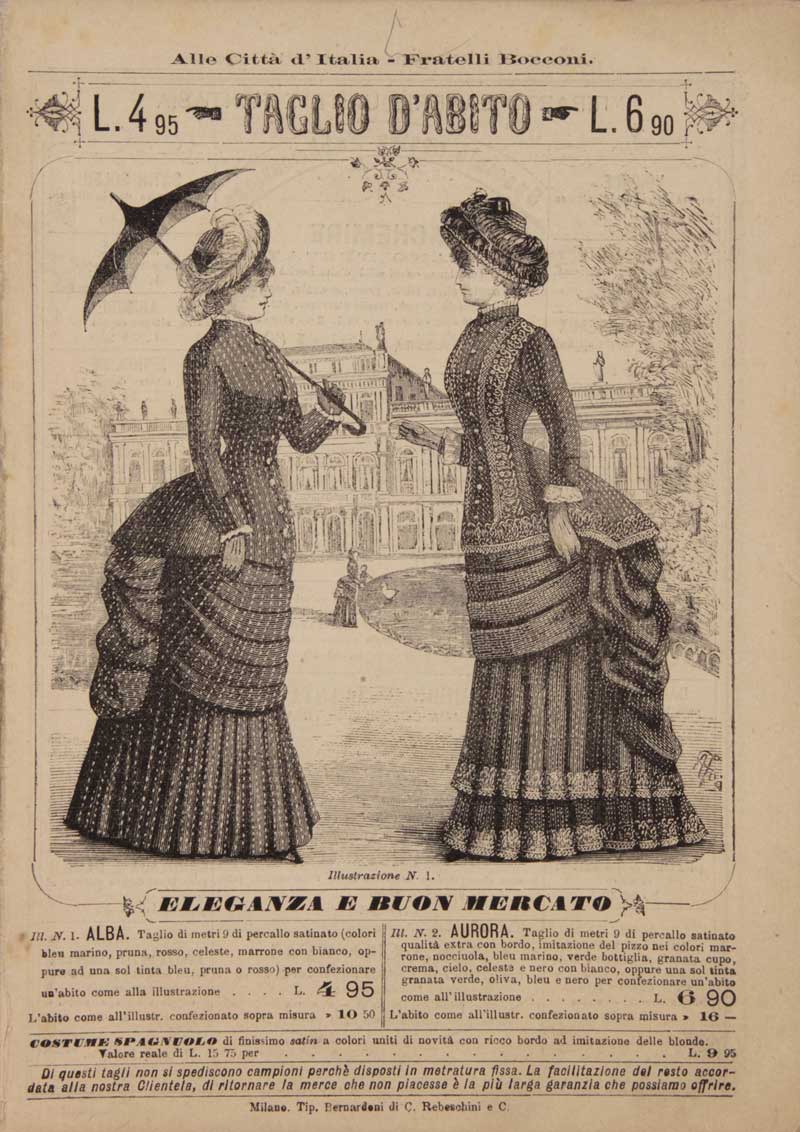
17 — Album Novità, Primavera-Estate 1883, periodico bimestrale, Milano, 1883, p. 1
Civica Raccolta delle Stampe Achille Bertarelli, Milano
The catalogues featured many pages with illustrations of individual items, akin to a true product showcase – from the smallest accessory to complement an outfit such as feathers, flowers and trimmings, to underwear with petticoats and corsets, divided into categories on different pages. Each picture had a brief description alongside or below.

18 — Album delle Novità dei Grandi Magazzini Alle Città d'Italia, Inverno 1888-89, periodico, Milano, 1888, p. 70
Civica Raccolta delle Stampe Achille Bertarelli, Milano
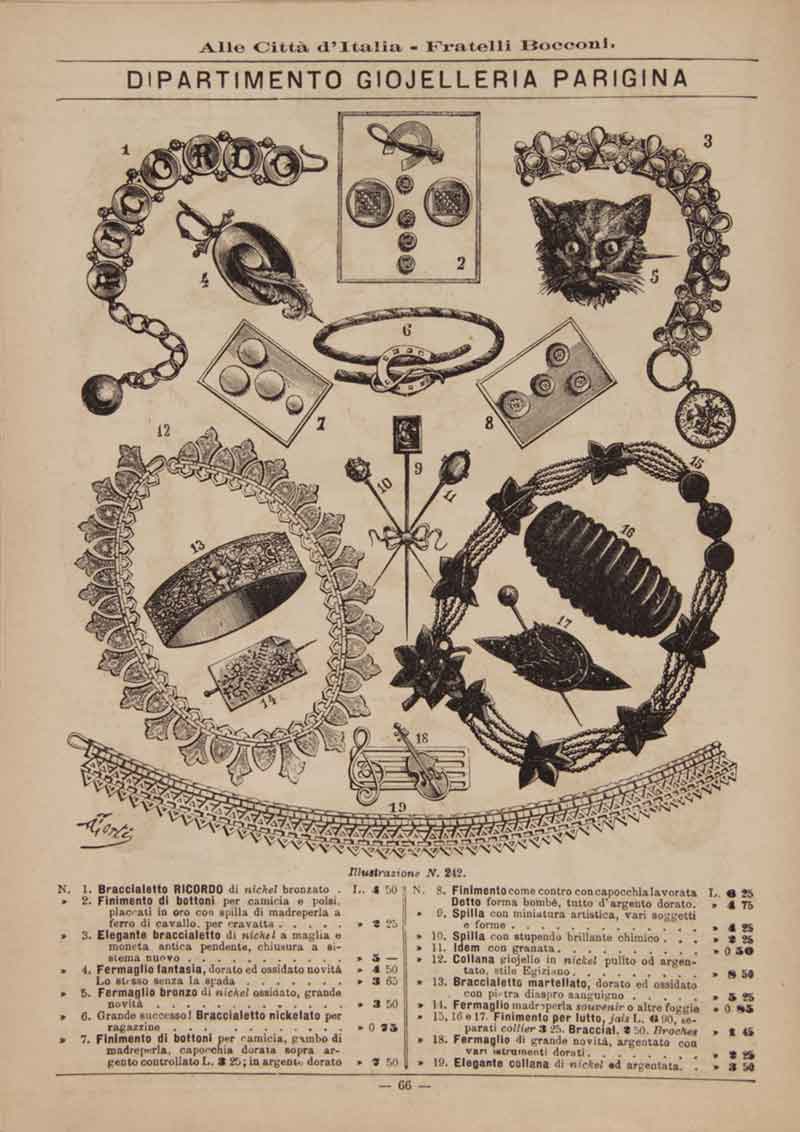
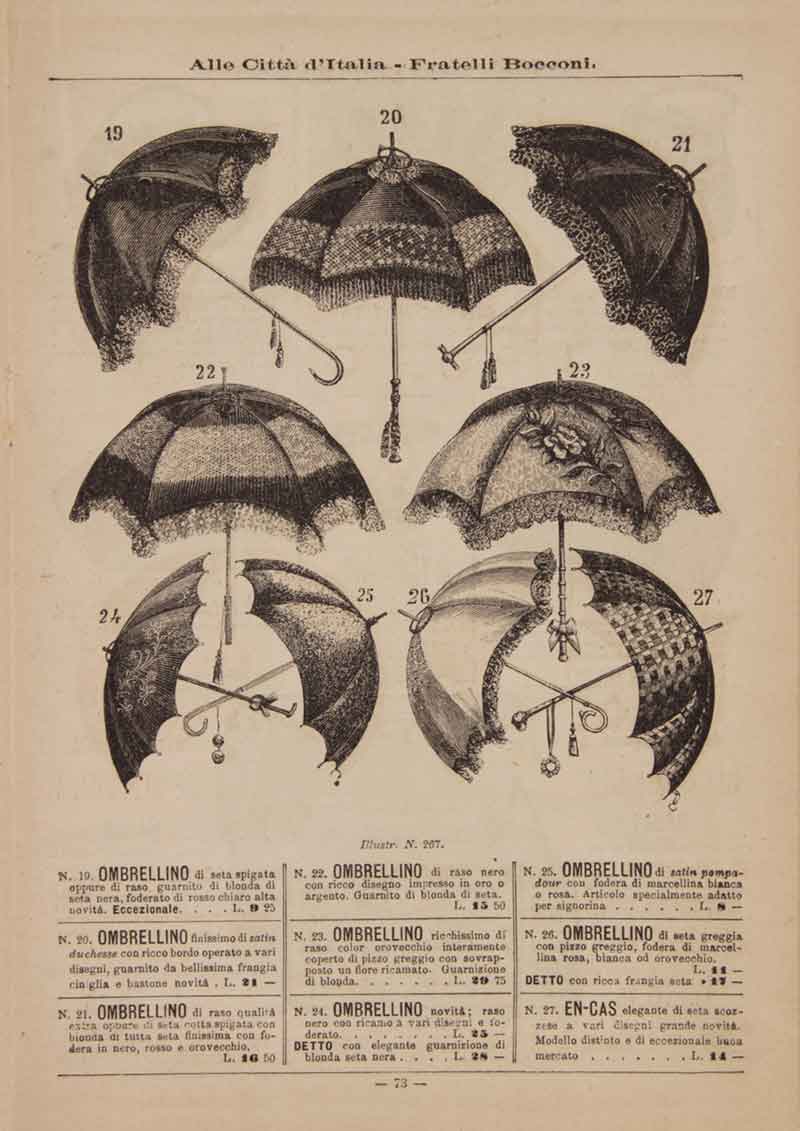
19 / 20 — Album Novità, Primavera-Estate 1883, periodico bimestrale, Milano, 1883, pp. 66, 73
Civica Raccolta delle Stampe Achille Bertarelli, Milano

21 — Grandi Magazzini Alle Città d'Italia, Biancheria, catalogo speciale di biancheria, Milano, 1883, p. 18
Civica Raccolta delle Stampe Achille Bertarelli, Milano
Other pages instead featured fashion plates, a fundamental element of the catalogues, especially in the ‘Album delle Novità’. There were almost always three plates per page, one next to the other, in various poses to illustrate the front, profile and back of the outfit. Under each plate was a description including the size, material, colour options and price of the outfit.


22 / 23 — Album Novità, Primavera-Estate 1883, periodico bimestrale, Milano, 1883, pp. 18, 24
Civica Raccolta delle Stampe Achille Bertarelli, Milano
In the beginning, the plates had no frame of reference, but from 1880 they began to be used within a setting that could encapsulate the situation and time of day with just a few basic elements that were able to convey an idea of the context suited to the outfit. One example is the illustration on page 19 in thespecial linen wear catalogue of 1880, where just a sofa and curtain immediately gave the idea of a domestic setting.
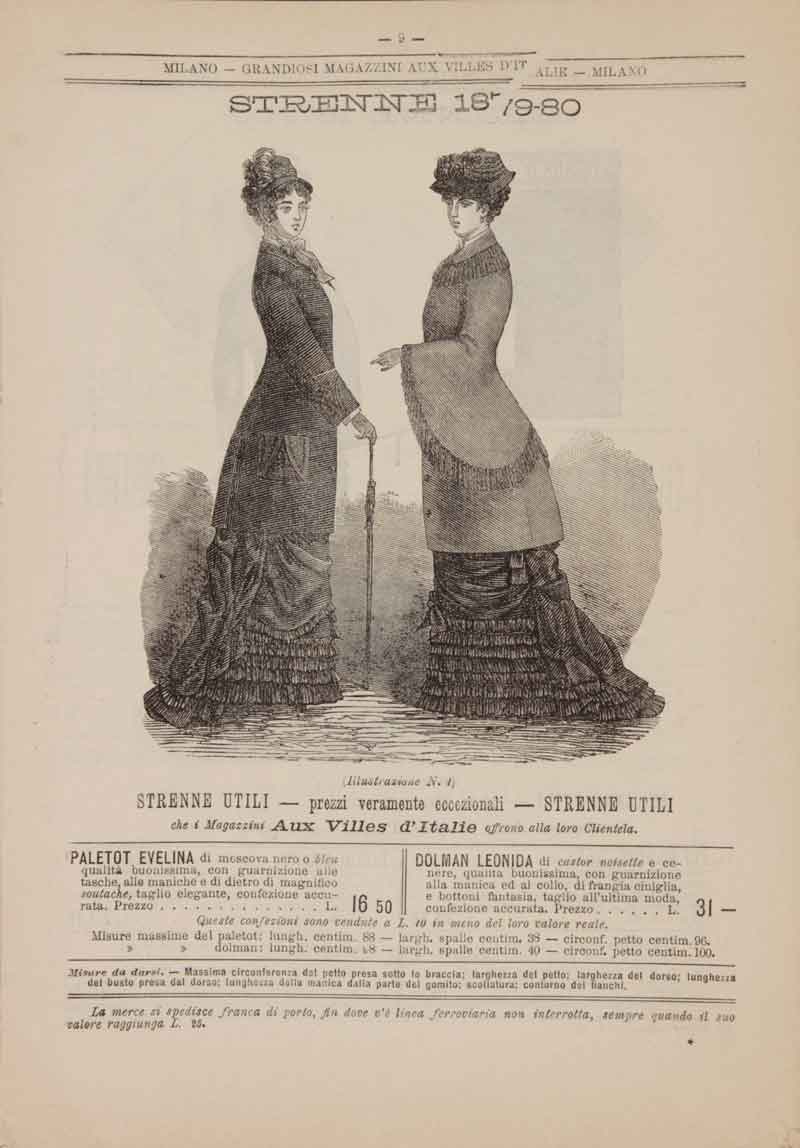
24 — Grandiosi Magazzini di Novità Aux Villes d'Italie. Strenne in oggetti utili e balocchi, catalogo speciale, Milano, dicembre 1879, p. 9
Civica Raccolta delle Stampe Achille Bertarelli, Milano

25 — Grandiosi Magazzini di Novità Aux Villes d'Italie. Annuale e Grande Esposizione, Biancheria, catalogo speciale di biancheria, Milano, 1880, p. 19
Civica Raccolta delle Stampe Achille Bertarelli, Milano

26 — Album Novità, Primavera-Estate 1883, periodico bimestrale, Milano, 1883, p. 27
Civica Raccolta delle Stampe Achille Bertarelli, Milano
During the 1880s, the settings became increasingly more detailed. The plates were more freely incorporated, but within a very precise context.
The setting was typically middle-class: family life, parties, walks and living room conversations all provided the background context to outfits recommended for such events, acting as pieces of advice on the ways and occasions they could be worn. Everything was characterised by a slight realism, which was a little fairytale-esque, suitable for representing a charming middle-class world that customers could imagine themselves in.

27 — Grandi Magazzini Alle Città d'Italia, Biancheria, catalogo speciale di biancheria, Milano, 1883, p. 1, Particolare di illustrazione
Civica Raccolta delle Stampe Achille Bertarelli, Milano
The catalogues illustrated menswear and childrens’ wear with the same careful attention to detail.

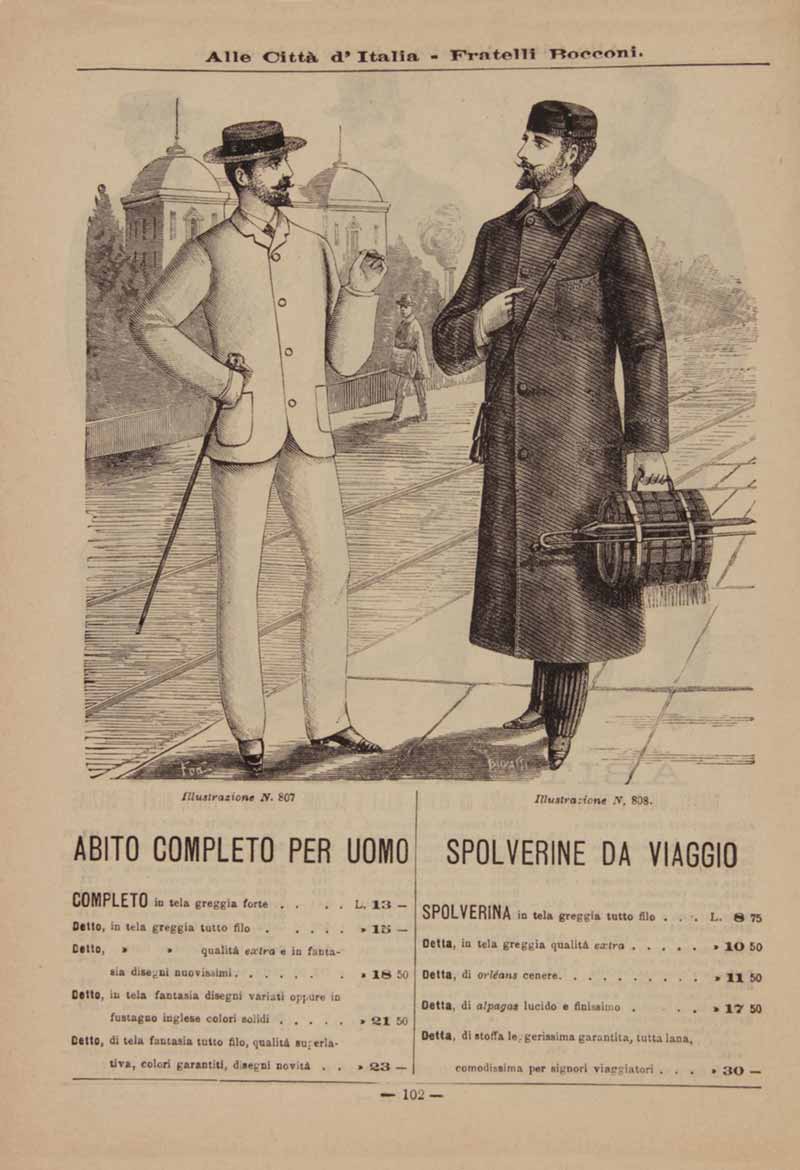
28 / 29 — Album delle Novità dei Grandi Magazzini Alle Città d'Italia, Estate 1887, periodico trimestrale, a. X, n. 30, Milano, 1887, pp. 99, 102
Civica Raccolta delle Stampe Achille Bertarelli, Milano
Both the cover and inside illustrations were signed by the artist, a sign of the growing importance of fashion illustration that now had need for professionals. The drawings, however, were not personalised – they adhered to a similar tradition of style and iconography, preventing any individual creativity or the expression of personal style.
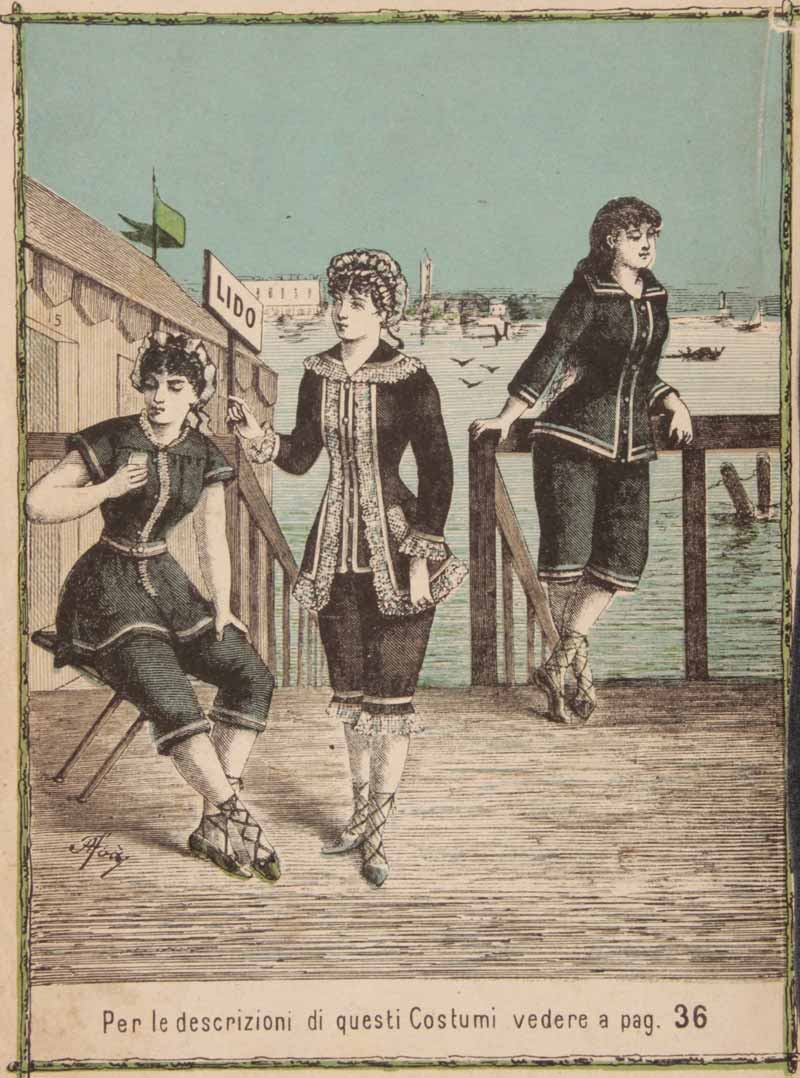
30 — Album Novità, Primavera-Estate 1883, periodico bimestrale, Milano, 1883, quarta di copertina
Civica Raccolta delle Stampe Achille Bertarelli, Milano
The last publications of the Bocconi Brothers, in the early twentieth century, were little different from those of the previous century, despite a greater freedom in the drawing and page layout, and greater expressivity of the plates that began to feature the personal touches of their artists. The silhouettes also began to change, in line with the fashion trends, becoming slimmer and more slender.

31 — Album Novità Autunno-Inverno 1904-05, periodico trimestrale, n. 94, Milano, settembre 1904, copertina
Civica Raccolta delle Stampe Achille Bertarelli, Milano

32 — Fratelli Bocconi Milano. Autunno Inverno 1903-04, periodico trimestrale, n. 90, Milano, settembre 1903, p. 5
Civica Raccolta delle Stampe Achille Bertarelli, Milano
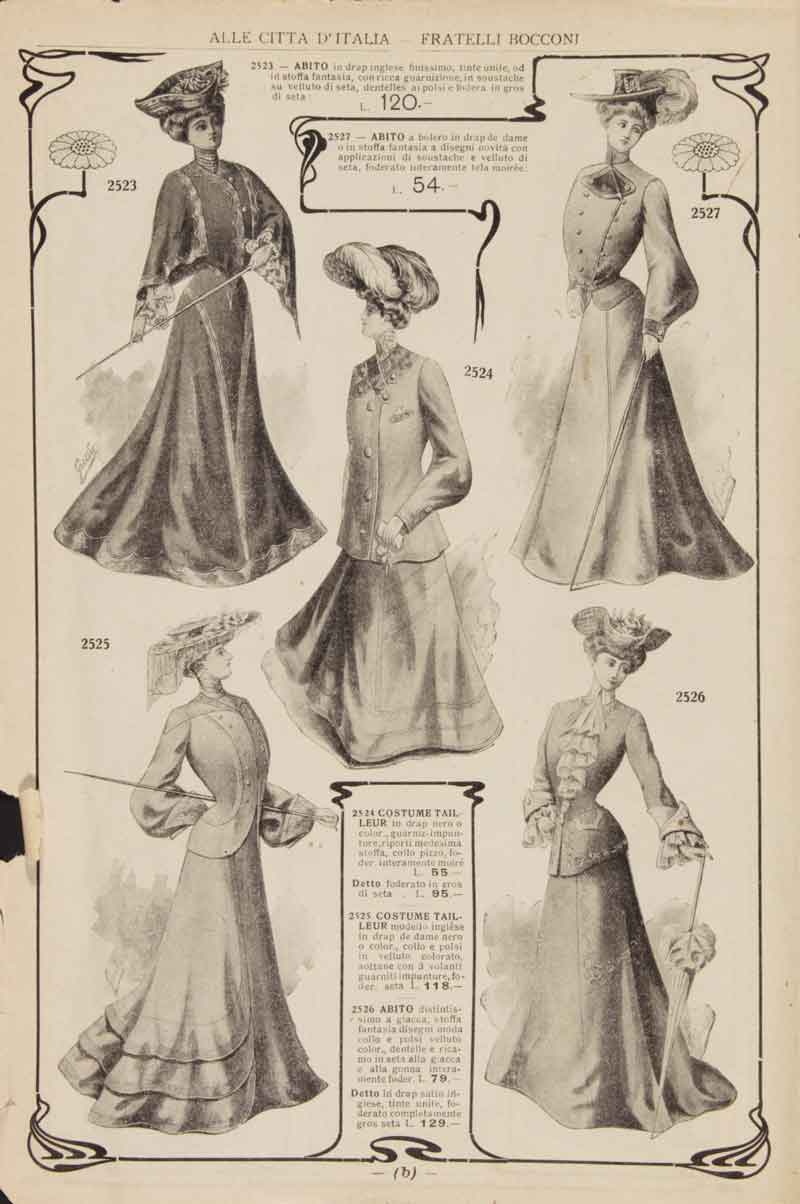
33 — Album Novità Autunno-Inverno 1904-05, periodico trimestrale, n. 94, Milano, settembre 1904
Civica Raccolta delle Stampe Achille Bertarelli, Milano
Rinascente’s fashion illustrations
In the twentieth century, the so-called “era of illustration” was welcomed in. Fashion drawings became true sources of artistic expression: no longer were they depictions, but pictures where the illustrator was free to convey the concept of fashion with his or her own artistic style. Drawing became generally simpler, with a more iconic and minimalist style far removed from the nineteenth-century naturalism, influenced by artistic trends and advertising posters.
Rinascente’s catalogues also felt the effect of these trends, although not greatly as their role of illustrating actual products for sale did not allow them to depart too far from reality.
The focus trends formed part of Senator Borletti’s plans to raise the taste and tone of the department stores which had just opened, and of their clientele. Visual communication was a vital part in conveying Rinascente’s new identity, not only with posters by the most important artists in the field, but also with catalogue illustrations featuring very elegant drawings and plates. These illustrations were intended to express the high quality of the products and to be images that its sophisticated customers could relate to.

34 — Le vetrine su piazza Duomo dei grandi magazzini la Rinascente, 1920 ca.
Touring Club Italiano, Milano
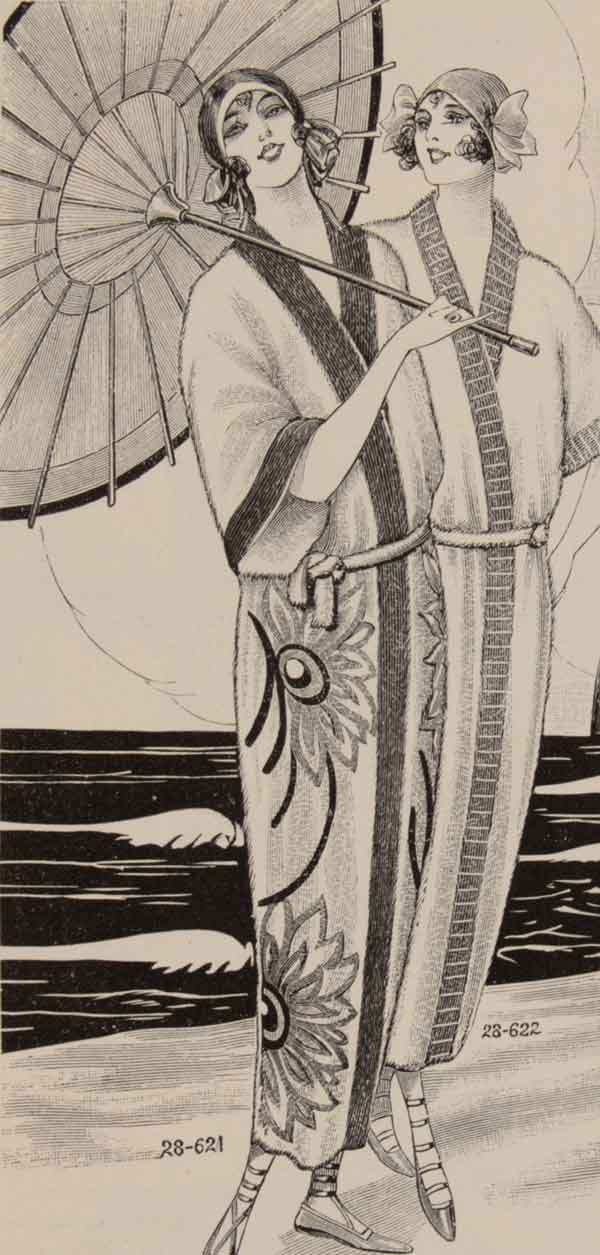
35 — la Rinascente, primavera-estate 1924, catalogo semestrale, n.6, Milano, 20 marzo 1924, p. 72
Particolare di illustrazione
Civica Raccolta delle Stampe Achille Bertarelli, Milano
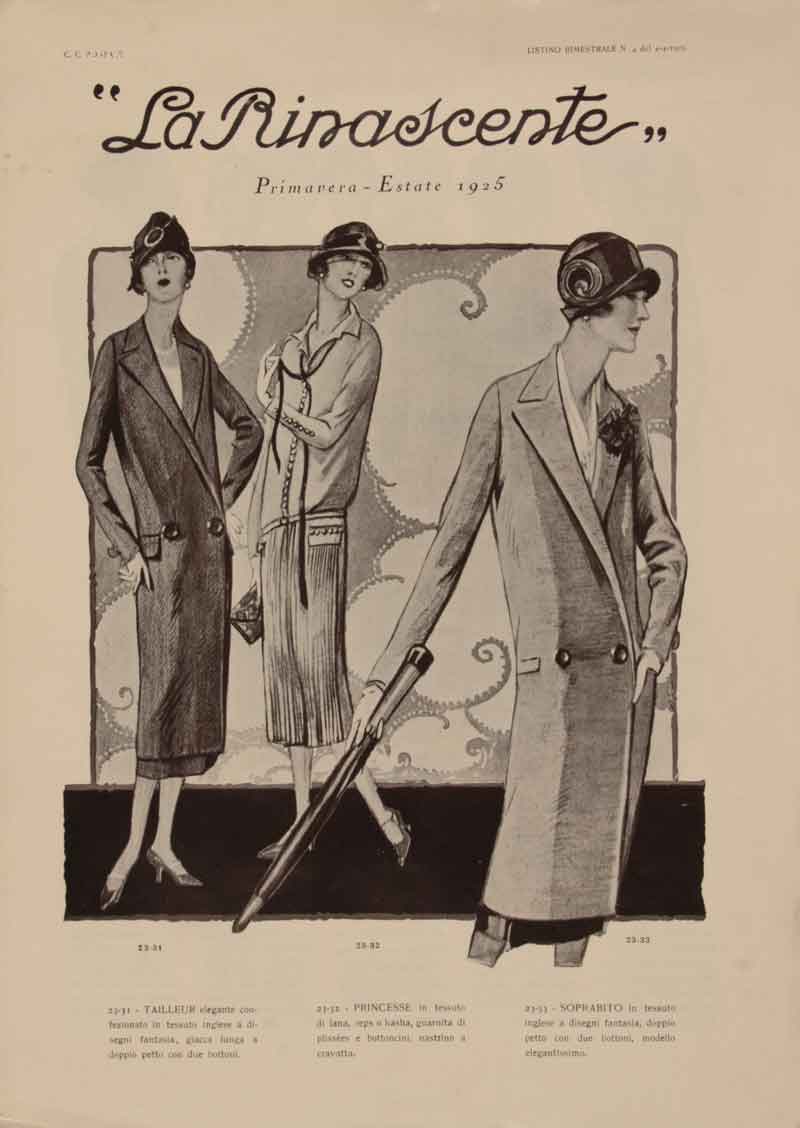
36 — la Rinascente, Primavera-Estate 1925, listino bimestrale, n. 4, Milano, 4 aprile 1925, copertina
Civica Raccolta delle Stampe Achille Bertarelli, Milano
The number of catalogues increased notably. The main issues were the biannual catalogues that preceded the winter and summer seasons. They featured all the new season’s Rinascente collections, from clothes and accessories to toys and tableware. The catalogues also had supplements that were published at different points in the season. The quarterly and bimonthly issues were dedicated to a specific theme – the latest products, seasonal sales, beach and country items, and special sales.
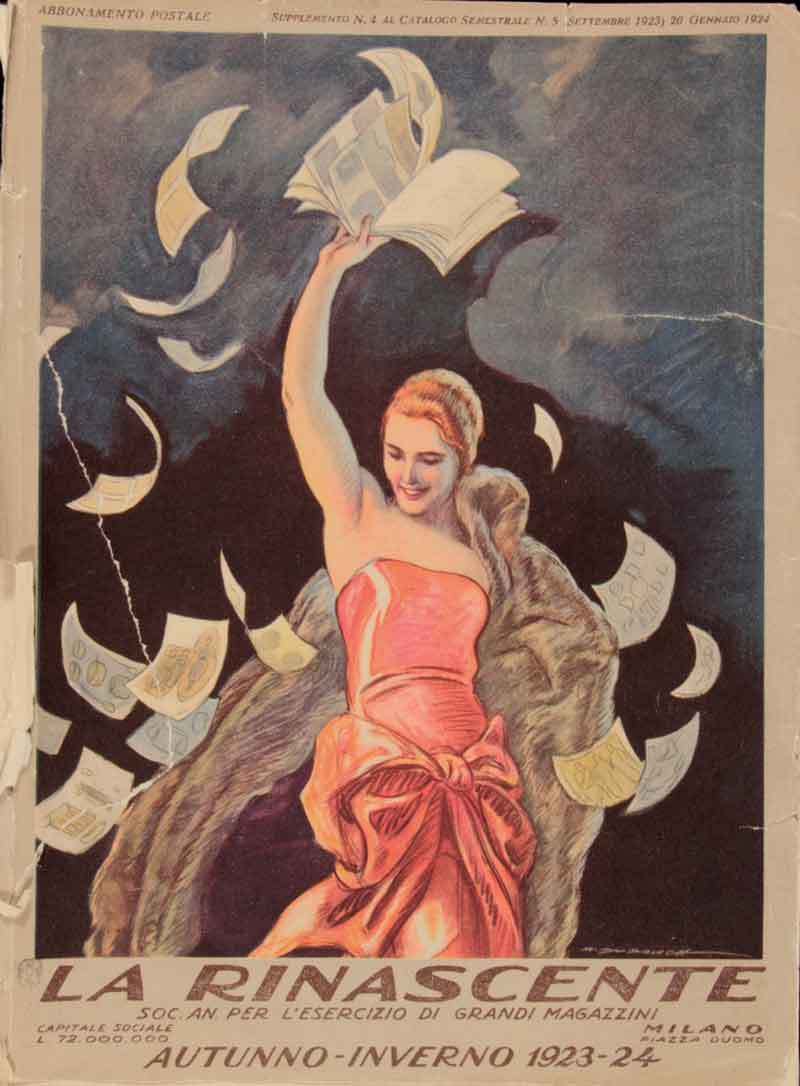
37 — la Rinascente, autunno-inverno 1923-24, supplemento n. 4 al catalogo semestrale n. 5 (settembre 1923), Milano, 20 gennaio 1924, copertina
Civica Raccolta delle Stampe Achille Bertarelli, Milano
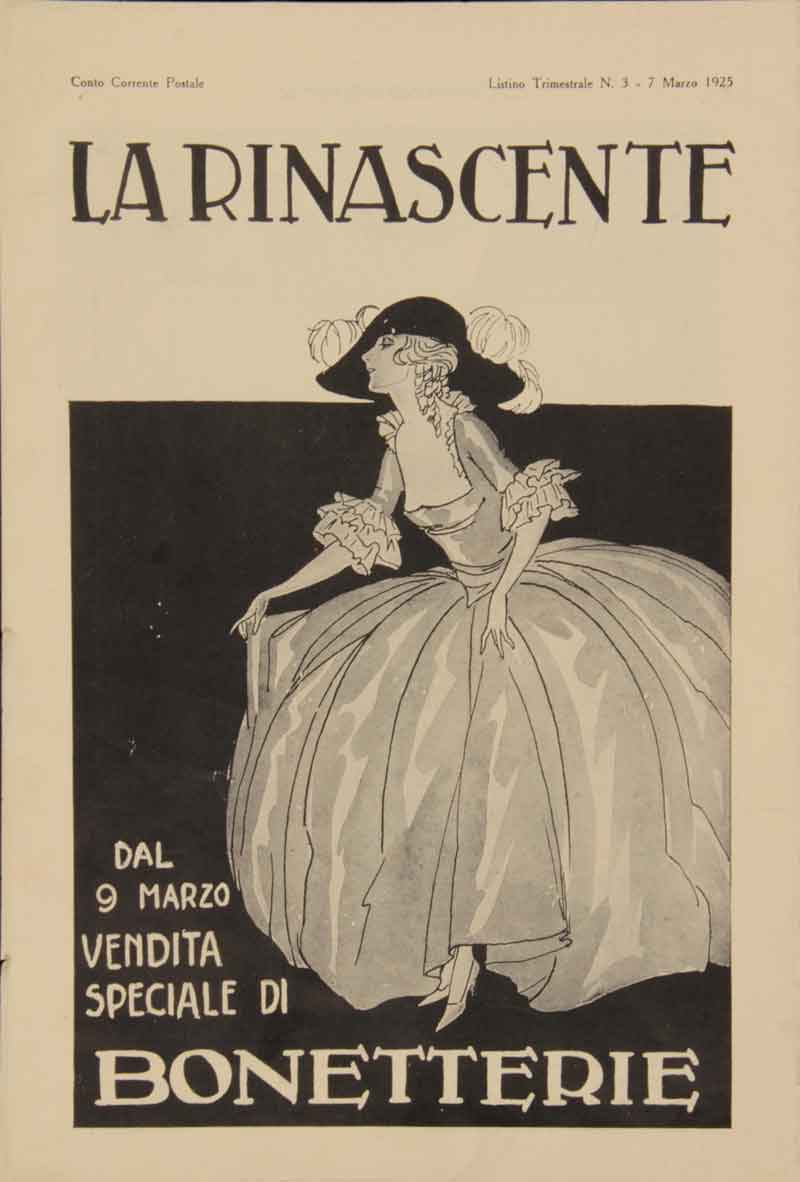
38 — la Rinascente, Bonetterie, listino trimestrale, n. 3, Milano, 7 marzo 1925, copertina
Civica Raccolta delle Stampe Achille Bertarelli, Milano

39 — la Rinascente, saldi di stagione, pubblicazione bimestrale, n. 6, Milano, 30 giugno 1925, copertina
Civica Raccolta delle Stampe Achille Bertarelli, Milano
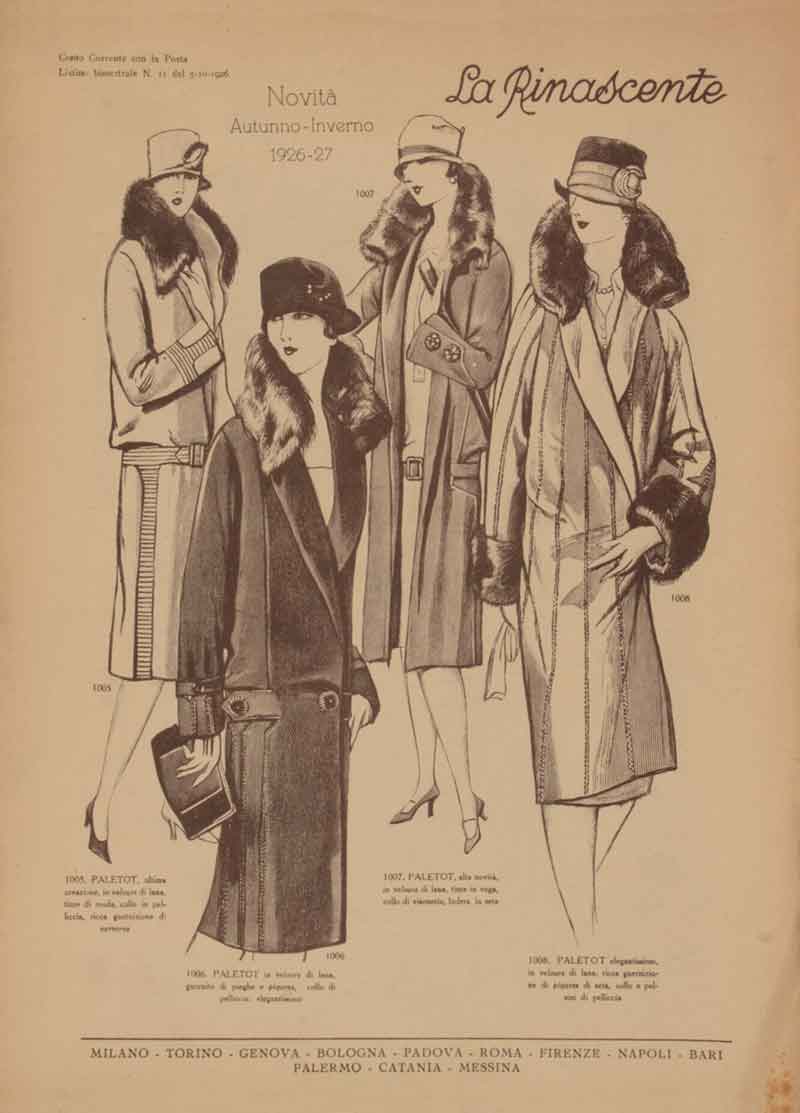
40 — la Rinascente, novità Autunno-Inverno 1926-27, listino bimestrale, n. 11, Milano, 5 ottobre 1926, copertina
Civica Raccolta delle Stampe Achille Bertarelli, Milano
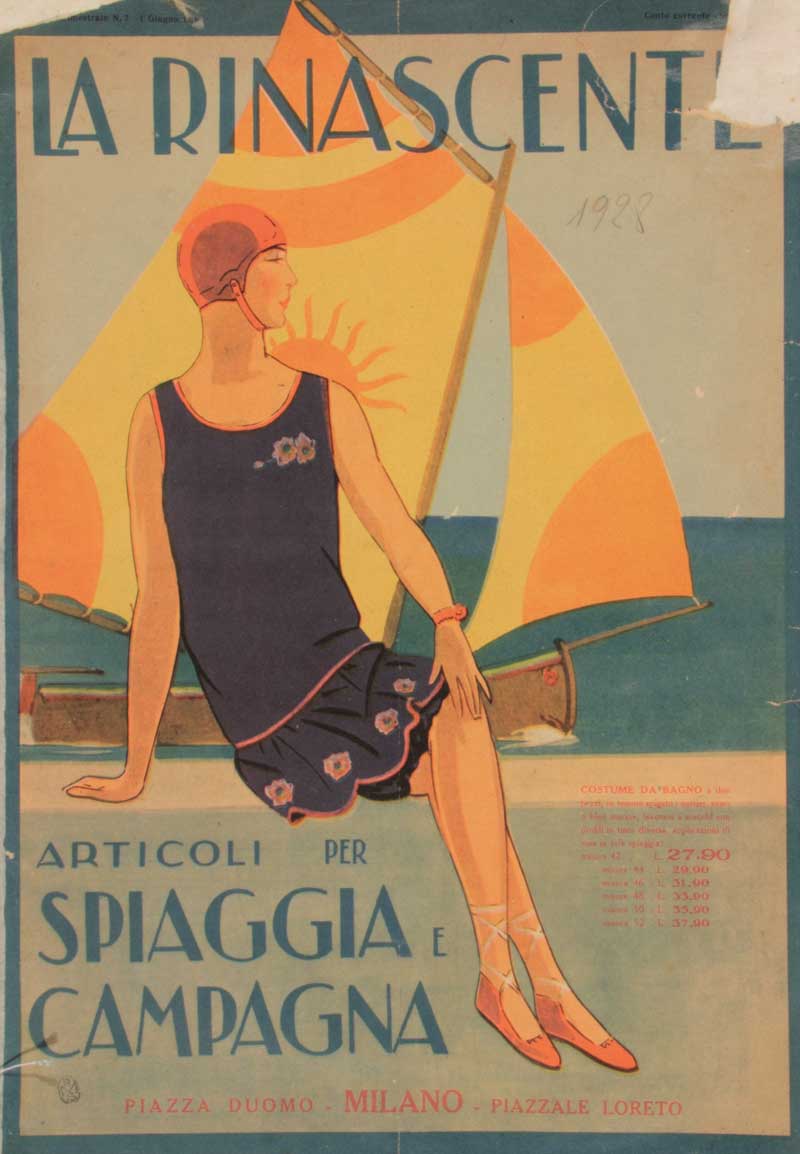
41 — la Rinascente, articoli per spiaggia e campagna, listino trimestrale, n. 7, Milano, 1 giugno 1928, copertina
Civica Raccolta delle Stampe Achille Bertarelli, Milano
The Rinascente catalogues and brochures maintained the same layout as those of the Bocconi brothers, with pages showing the individual items alternating with pages featuring fashion plates, with almost full-page illustrations alternating with short descriptive texts in a carefully arranged design.

42 — la Rinascente. Grande vendita per la villeggiatura, listino mensile, a. VII, n. 6, Milano, 15 maggio 1929, quarta di copertina
Civica Raccolta delle Stampe Achille Bertarelli, Milano
In the Twenties, in a departure from earlier catalogues, only a few pages showed models within descriptive settings. In most cases, the fashion plates were set against geometric and abstract backgrounds, sometimes coloured in light pastel shades. These were far removed from the realistic and detailed illustrations of the nineteenth-century catalogues. A diagonal catwalk often was featured, where the fashion plates were positioned in different poses.
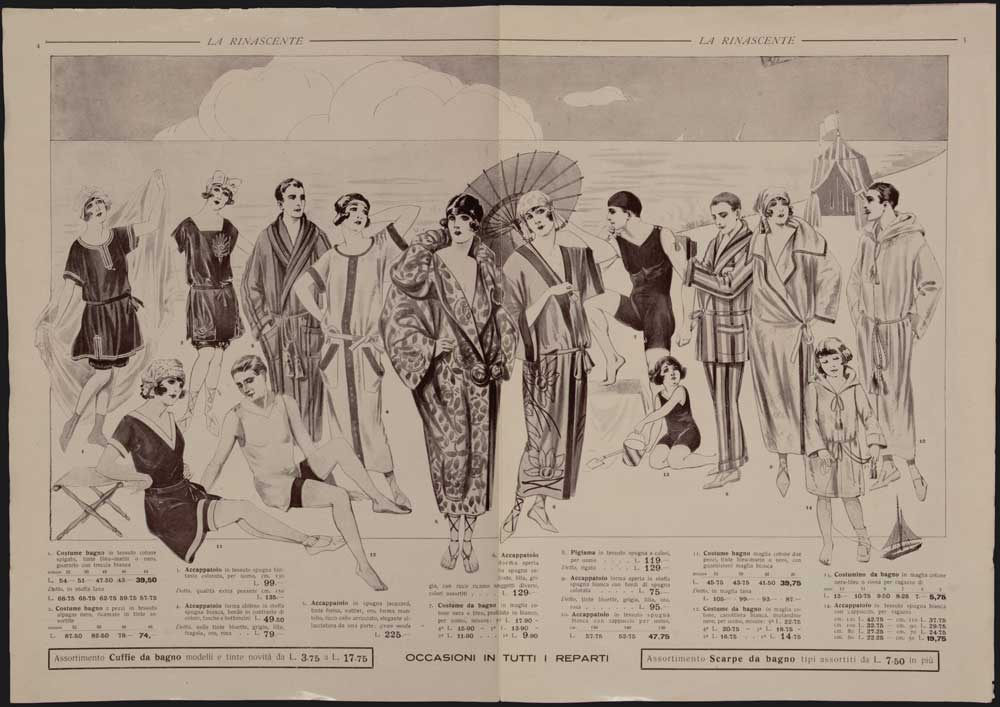
43 — la Rinascente. Articoli da spiaggia e campagna, listino bimestrale, n. 5, Milano, 1 giugno 1925, pp. 4-5
Civica Raccolta delle Stampe Achille Bertarelli, Milano

44 — la Rinascente. Apertura di Stagione Primavera-Estate 1928, listino bimestrale, n. 4, Milano, 1 aprile 1928, p. 5
Civica Raccolta delle Stampe Achille Bertarelli, Milano
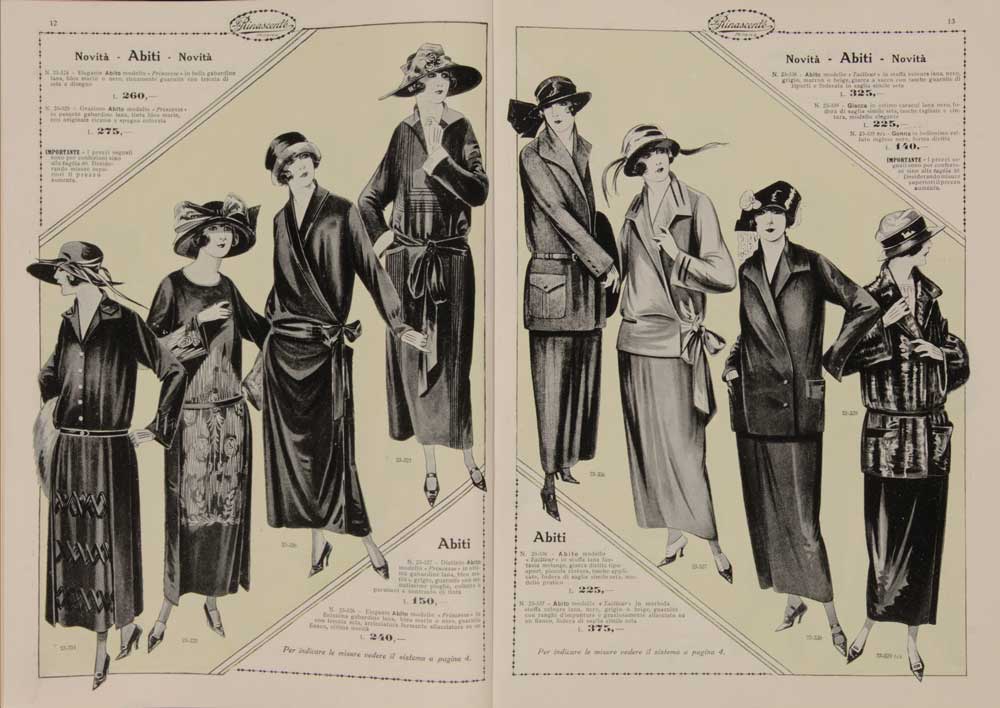
45 — la Rinascente, autunno-inverno 1923-24, supplemento n. 4 al catalogo semestrale n. 5 (settembre 1923), Milano, 20 gennaio 1924, pp. 12-13
Civica Raccolta delle Stampe Achille Bertarelli, Milano
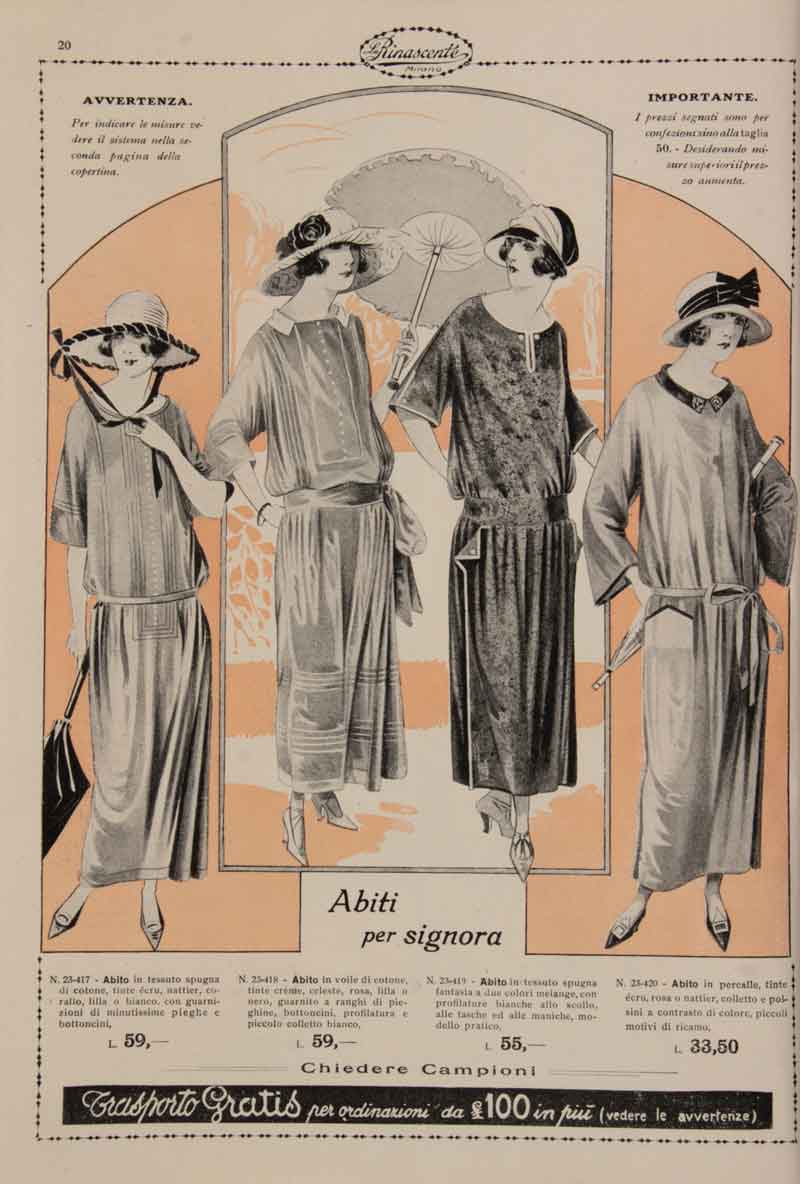
46 — la Rinascente, primavera-estate 1924, catalogo semestrale, n. 6, Milano, 20 marzo 1924, p. 20
Civica Raccolta delle Stampe Achille Bertarelli, Milano
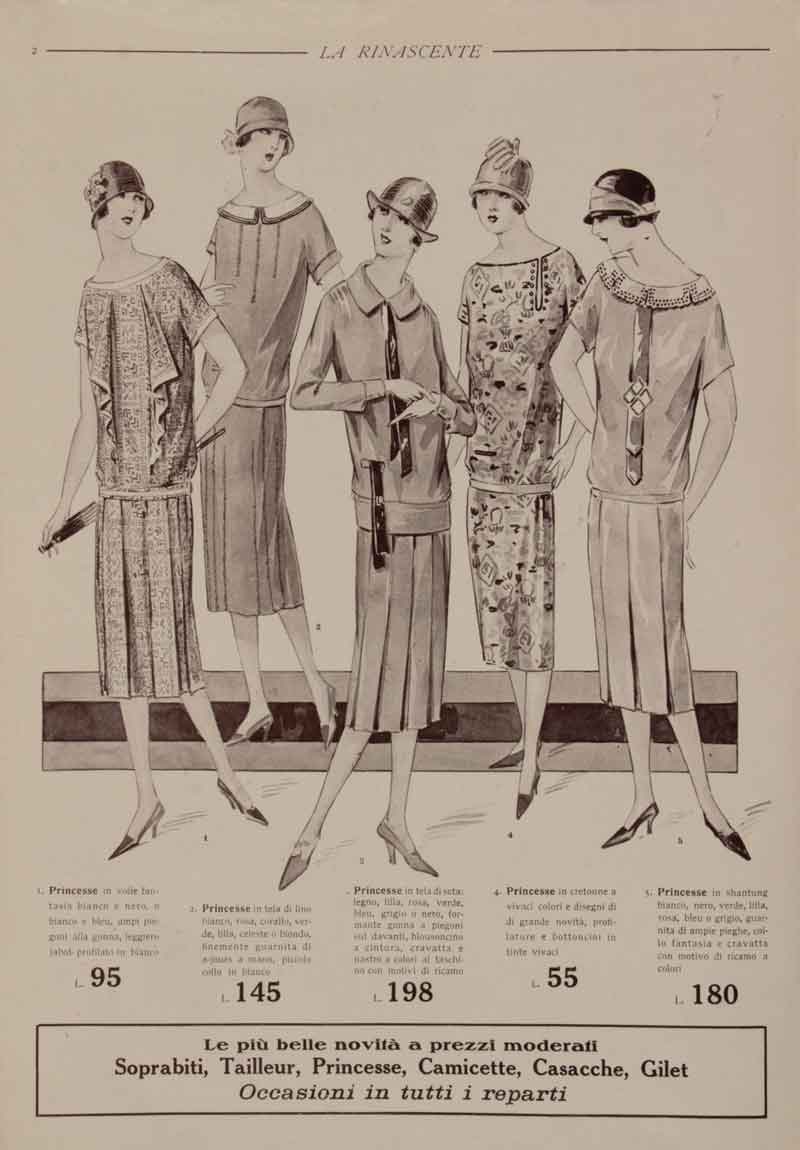
47 — la Rinascente. Articoli da spiaggia e campagna, listino bimestrale, n. 5, Milano, 1 giugno 1925, p. 2
Civica Raccolta delle Stampe Achille Bertarelli, Milano
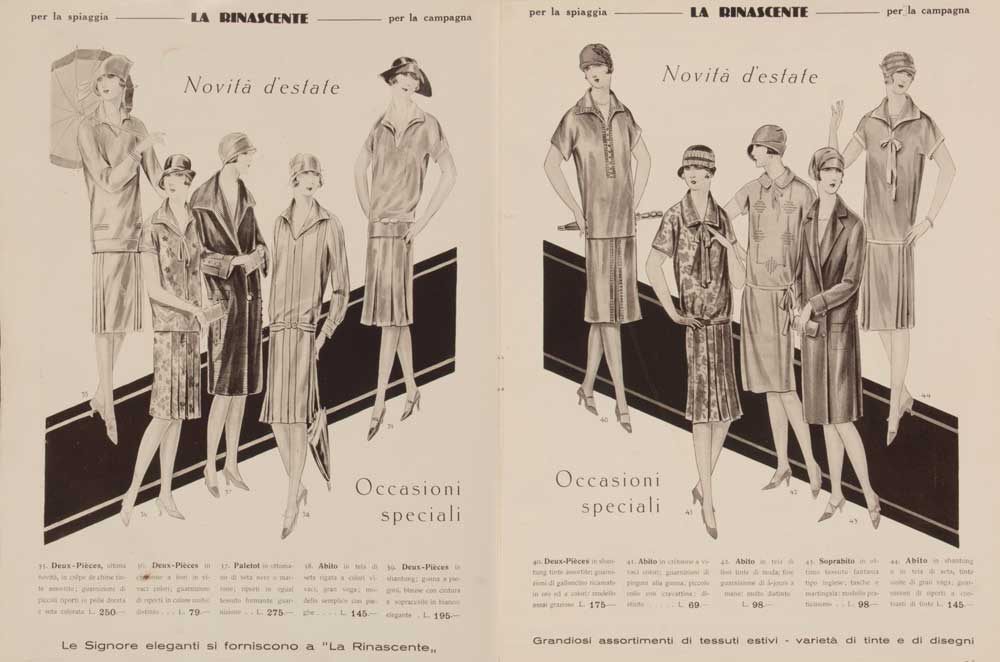
48 — la Rinascente, grande vendita articoli da spiaggia e da campagna, listino bimestrale, n. 7, Milano, 1 giugno 1926, pp. 1-2
Civica Raccolta delle Stampe Achille Bertarelli, Milano
Above all, the style of drawing had changed, influenced by poster art and top French illustrators who collaborated with fashion designers and major fashion magazines. A new style and taste were emerging, defined by two-dimensional images clearly influenced by Japanese prints and Art Déco which, with its geometric shapes and apparent simplicity, had superseded the more complex linearity of Art Nouveau.
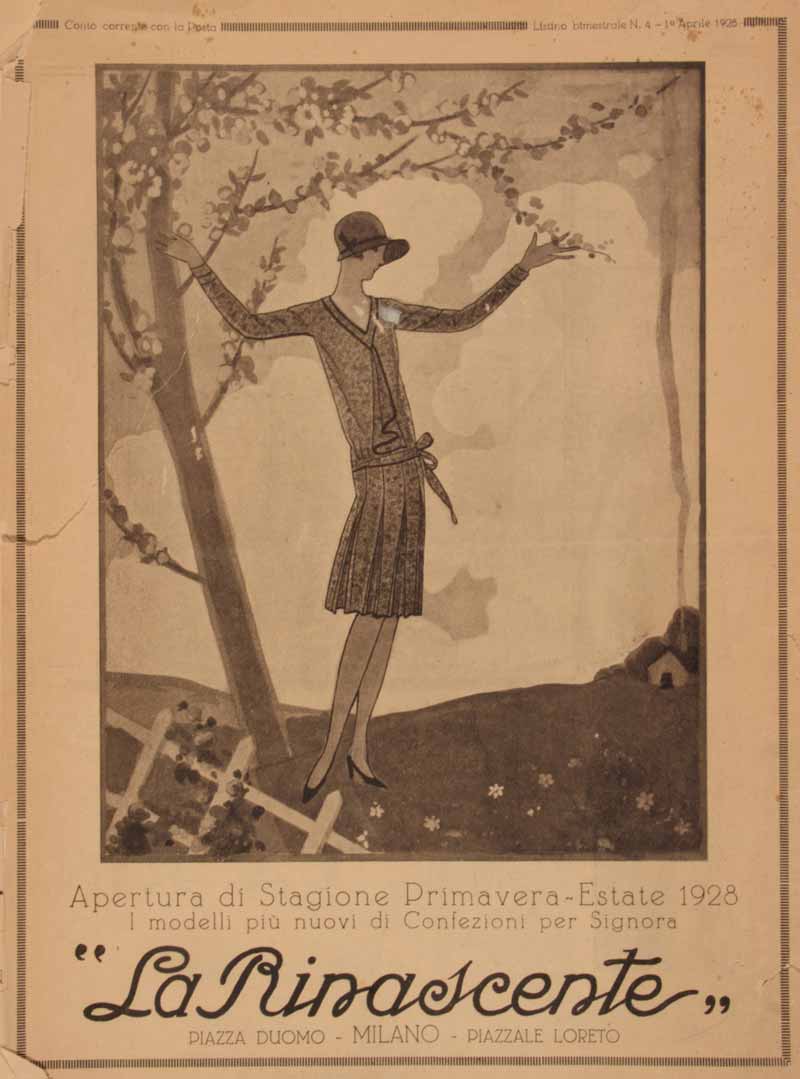
49 — la Rinascente, apertura di stagione Primavera-Estate 1928, listino bimestrale, n. 4, Milano, 1 aprile 1928, copertina
Civica Raccolta delle Stampe Achille Bertarelli, Milano

50 — la Rinascente, novità primavera 1929, listino mensile, a. VII, n. 4, Milano, 15 marzo1929, copertina
Civica Raccolta delle Stampe Achille Bertarelli, Milano
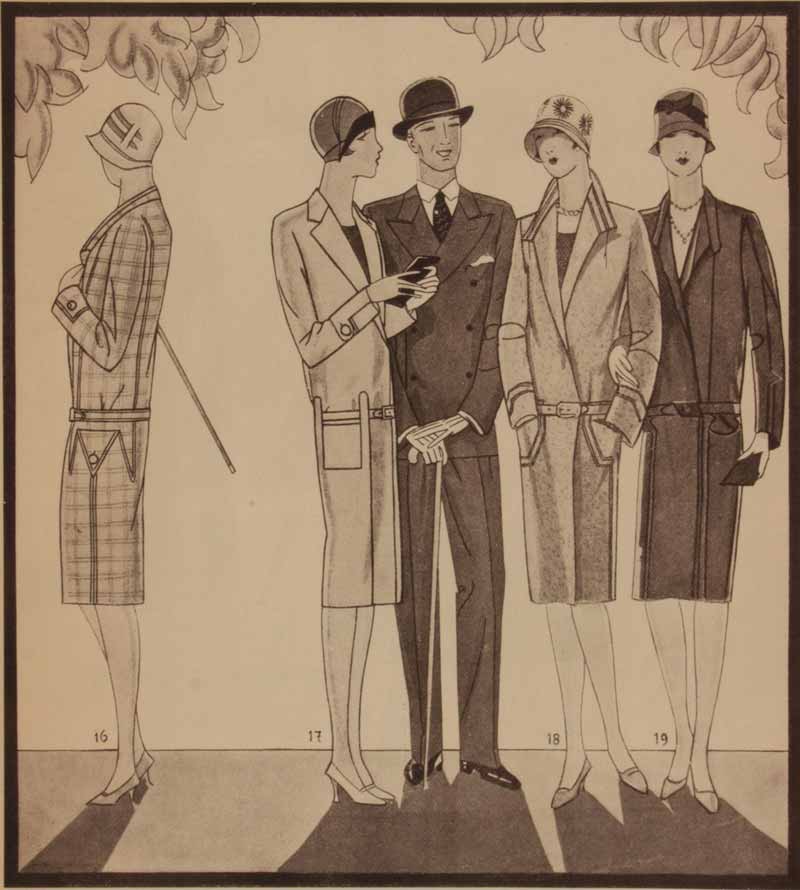
51 — la Rinascente, apertura di stagione Primavera-Estate 1928, listino bimestrale, n. 4, Milano, 1 aprile 1928, p. 6
Particolare di illustrazione
Civica Raccolta delle Stampe Achille Bertarelli, Milano
Not only had a new style of drawing emerged, but also a new female silhouette - extremely elegant, tall, slim and without any protruding forms. This was true particularly in the second half of the decade, when plates became increasingly tapered and slender.

52 — la Rinascente, novità primavera 1929, listino mensile, a. VII, n. 4, Milano, 15 marzo1929, p. 6
Civica Raccolta delle Stampe Achille Bertarelli, Milano
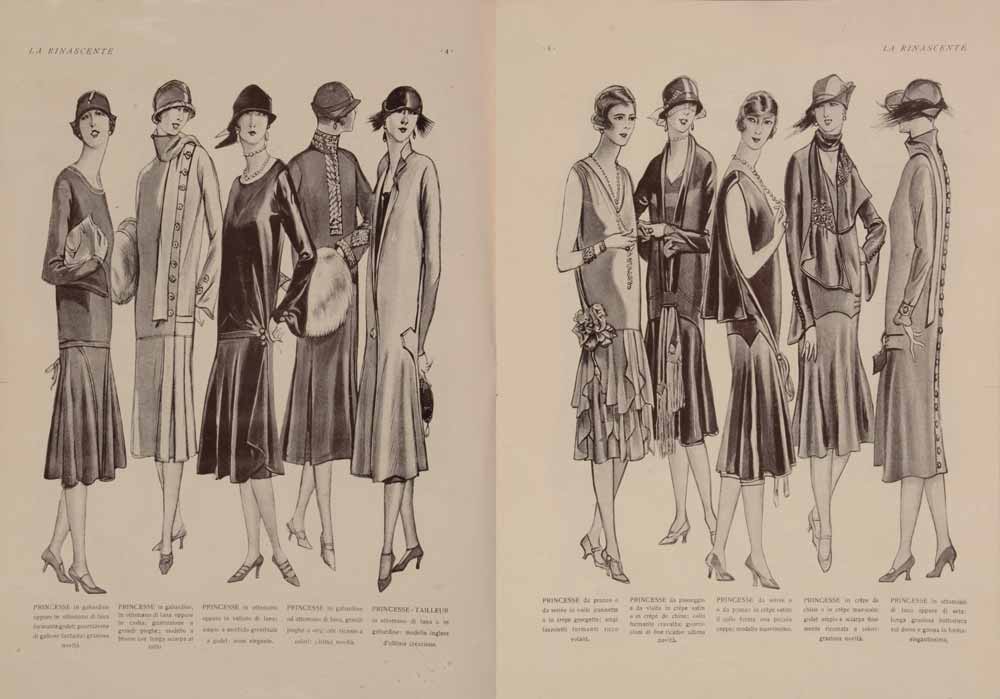
53 — la Rinascente. Autunno Inverno 1925-1926, listino, n. 7, Milano, 1 ottobre 1925, pp. 4-5
Civica Raccolta delle Stampe Achille Bertarelli, Milano
Faces, on top of long necks in the style of Italian artist Modigliani, featured almond-shaped eyes and small heart-shaped mouths, just like those in the most avantgarde fashion magazines.
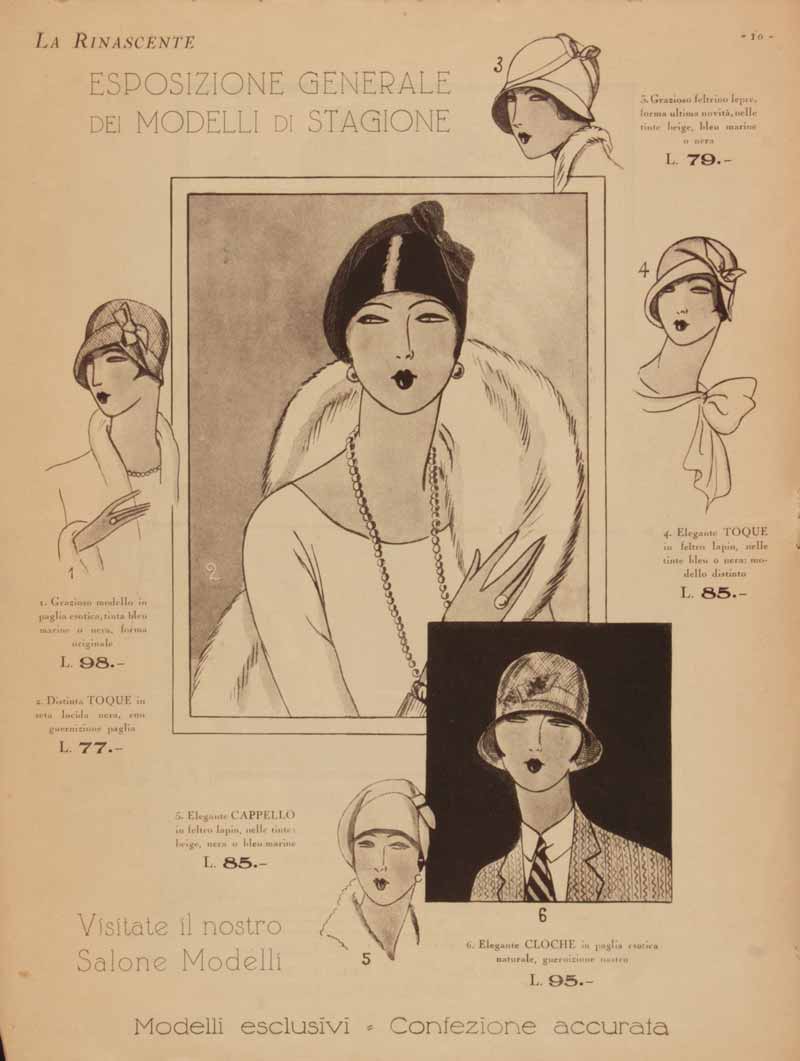
54 — la Rinascente, apertura di stagione Primavera-Estate 1928, listino bimestrale, n. 4, Milano, 1 aprile 1928, p. 10
Civica Raccolta delle Stampe Achille Bertarelli, Milano

55 — la Rinascente, novità primavera 1929, listino mensile, a. VII, n. 4, Milano, 15 marzo1929, p. 1
Particolare di illustrazione
Civica Raccolta delle Stampe Achille Bertarelli, Milano
These characteristics were more common on the covers where, unlike the inside illustrations, there was greater creative license. One example was the brochure cover ‘la Rinascente. Autumn-Winter 1925-1926’ which featured quasi-geometric models, in an original style that combined soft lines with geometric and stylised shapes which showed an obvious influence taken from the avantgarde and particularly Cubist movements.
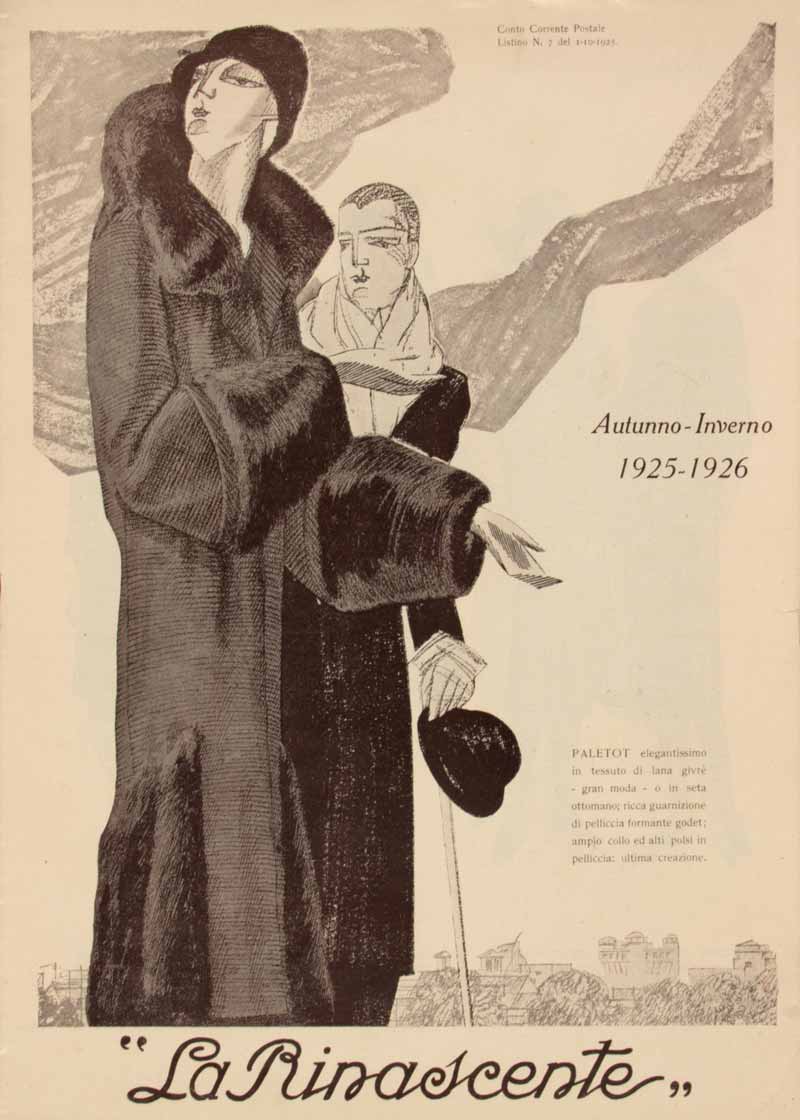
56 — la Rinascente. Autunno Inverno 1925-1926, listino, n. 7, Milano, 1 ottobre 1925, copertina
Civica Raccolta delle Stampe Achille Bertarelli, Milano
Some covers were in colour, characterised by very bright hues that echoed the fashion drawings of George Lepape or Sonia Delaunay, with flat backgrounds that emphasised the two-dimensionality of the fashion plates and the abstract backgrounds, which were increasingly geometric and unrealistic.
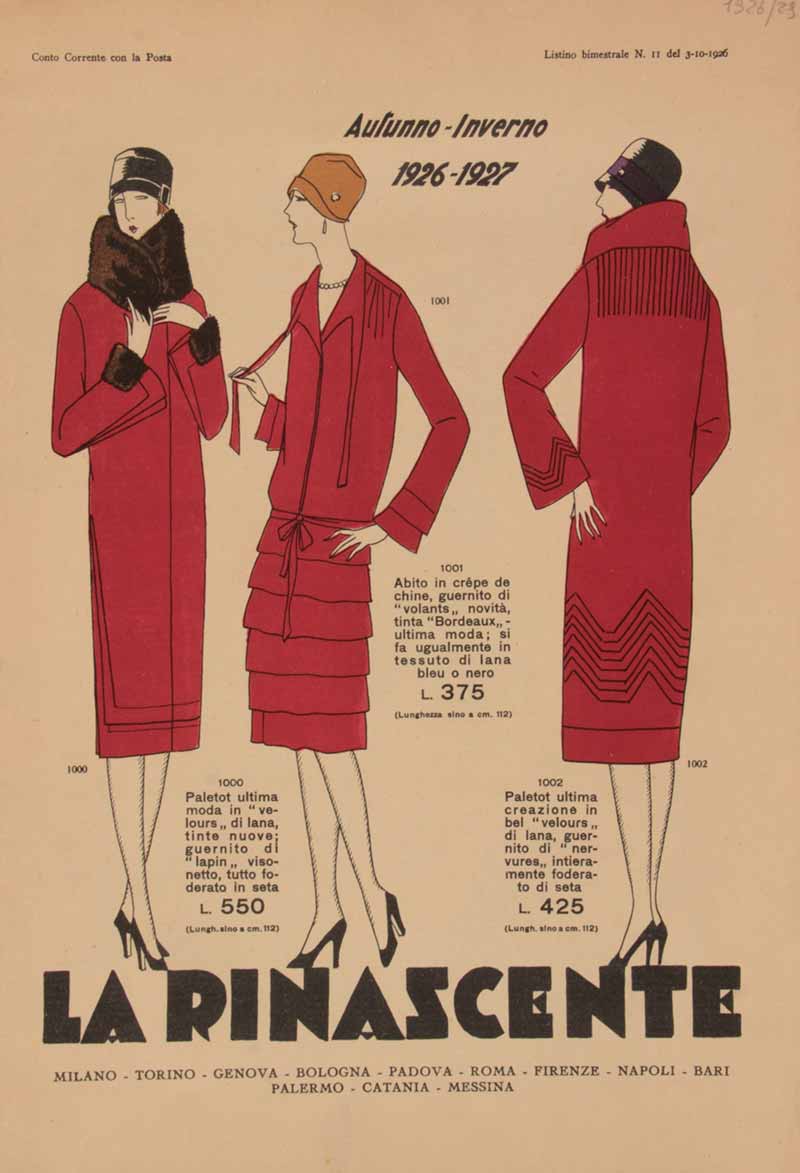
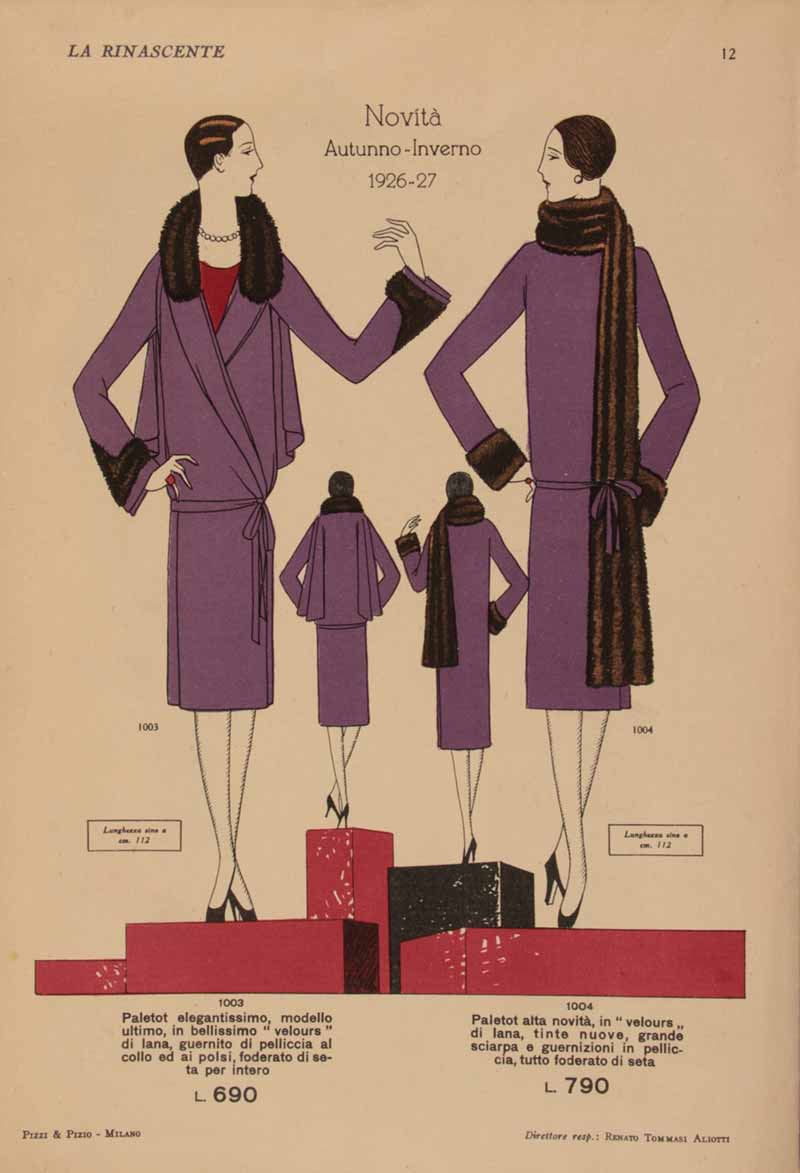
57 / 58 — la Rinascente. Autunno-Inverno 1926-1927, listino bimestrale, n. 11, Milano, 3 ottobre 1926, copertina e quarta di copertina
Civica Raccolta delle Stampe Achille Bertarelli, Milano

59 — la Rinascente. Primavera-Estate, le ultime novità della stagione, listino bimestrale, n. 4, Milano, 27 marzo 1926, quarta di copertina
Civica Raccolta delle Stampe Achille Bertarelli, Milano
At the end of the decade, the fashion plates began again to be put in more realistic settings, and regained greater shape and physical three-dimensionalism, heralding the trend of the next decade.

60 — la Rinascente. Grande vendita per la villeggiatura, listino mensile, a. VII, n. 6, Milano, 15 maggio 1929, copertina
Civica Raccolta delle Stampe Achille Bertarelli, Milano

61 — la Rinascente. Grande vendita per la villeggiatura, listino mensile, a. VII, n. 6, Milano, 15 maggio 1929, inserto pieghevole
Civica Raccolta delle Stampe Achille Bertarelli, Milano
In the Thirties, the androgynous female figure was left behind in favour of a curvier woman, a result of the major anti-thinness campaign. The illustrations in Rinascente catalogues, in line with the latest trends, presented very different silhouettes – the excessively tall and flat models of the last decade were set aside and robust models took their place, with a style that practically trivialised the typical shapes of the reigning aesthetics.
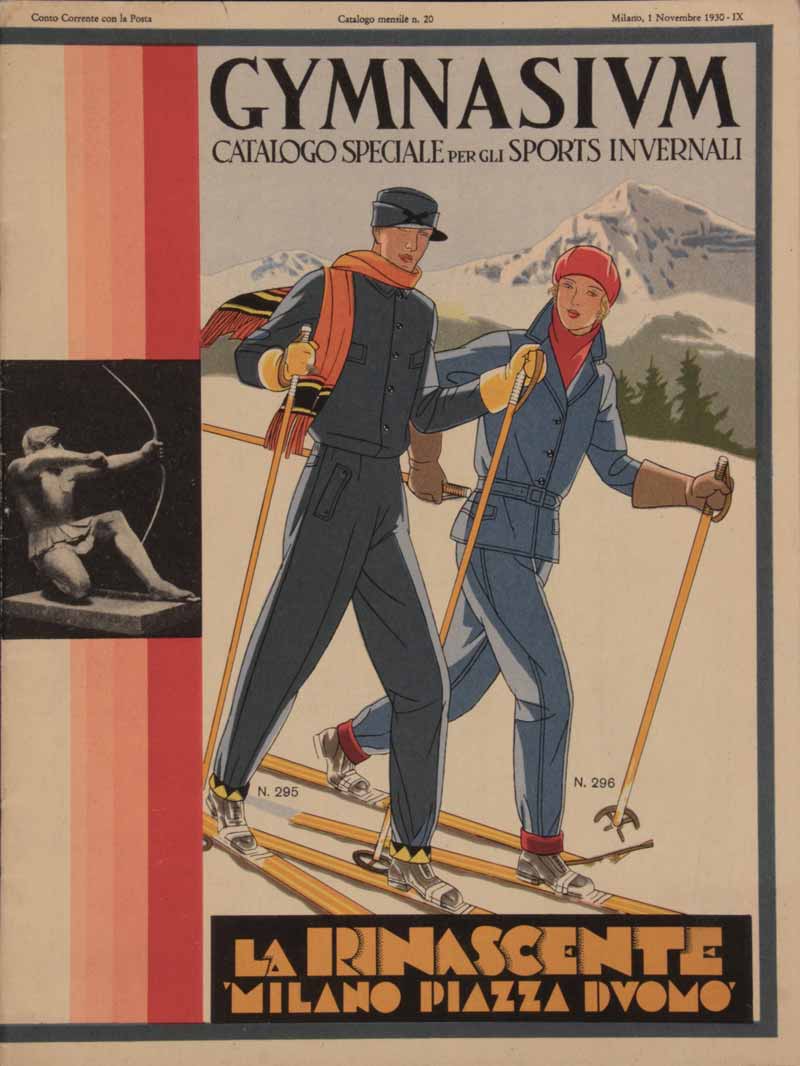
62 — Gymnasium, catalogo mensile, a. IX, n. 20, Milano, 1 novembre 1930, copertina
Civica Raccolta delle Stampe Achille Bertarelli, Milano
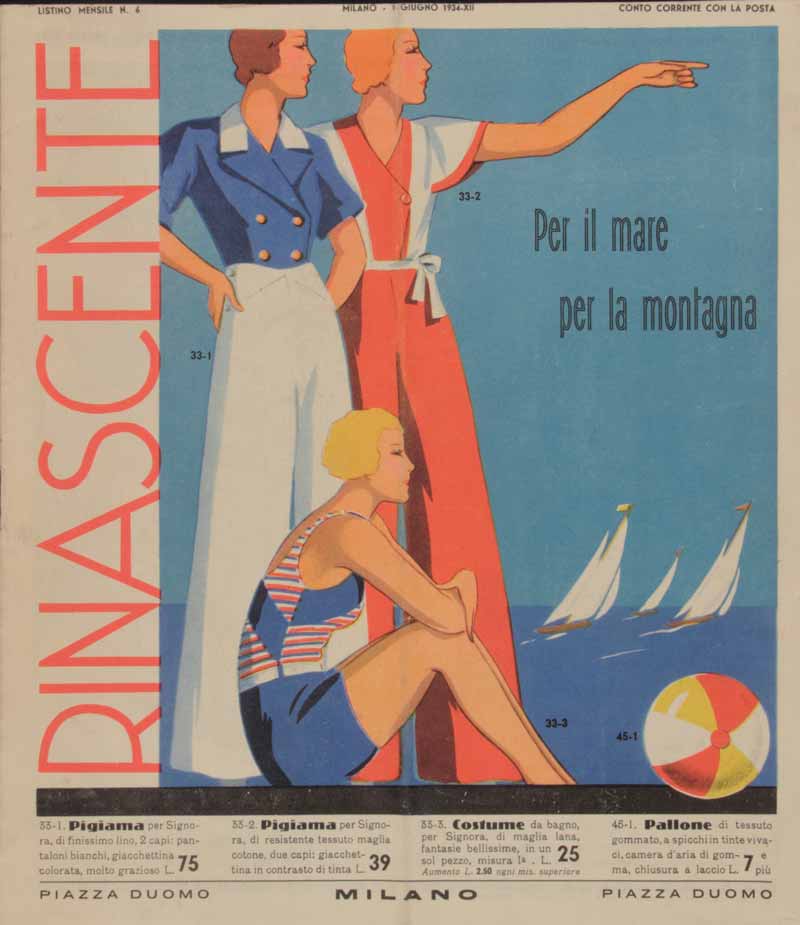
63 — Rinascente. Per il mare per la montagna, listino mensile, a. XII, n. 6, Milano, 1 giugno 1934, copertina
Civica Raccolta delle Stampe Achille Bertarelli, Milano
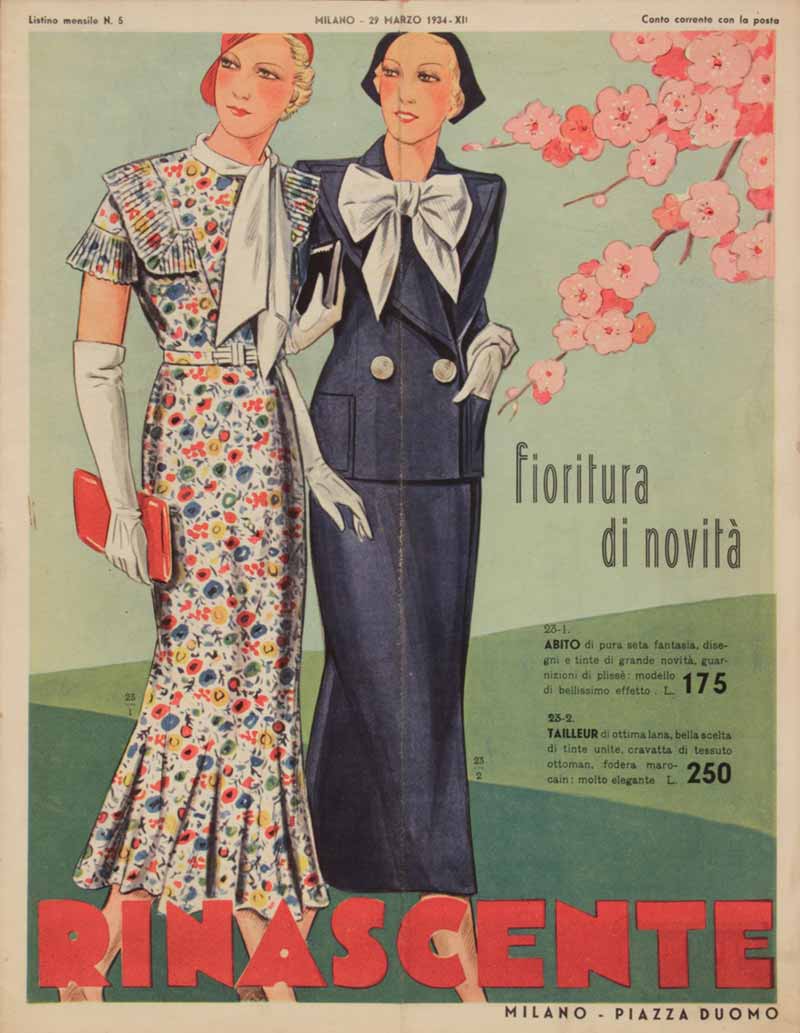

64 / 65 — Rinascente, fioritura di novità, Milano, listino mensile, a. XII, n. 5, Milano, 29 marzo 1934, copertina e quarta di copertina
Civica Raccolta delle Stampe Achille Bertarelli, Milano
From the mid-Thirties, in keeping with the general revival of designs that showed fashion more realistically, Rinascente catalogues established a new realistic and playful illustrative style, with more pictorial and precise features, moving away from the two-dimensionality of the previous decade for good.
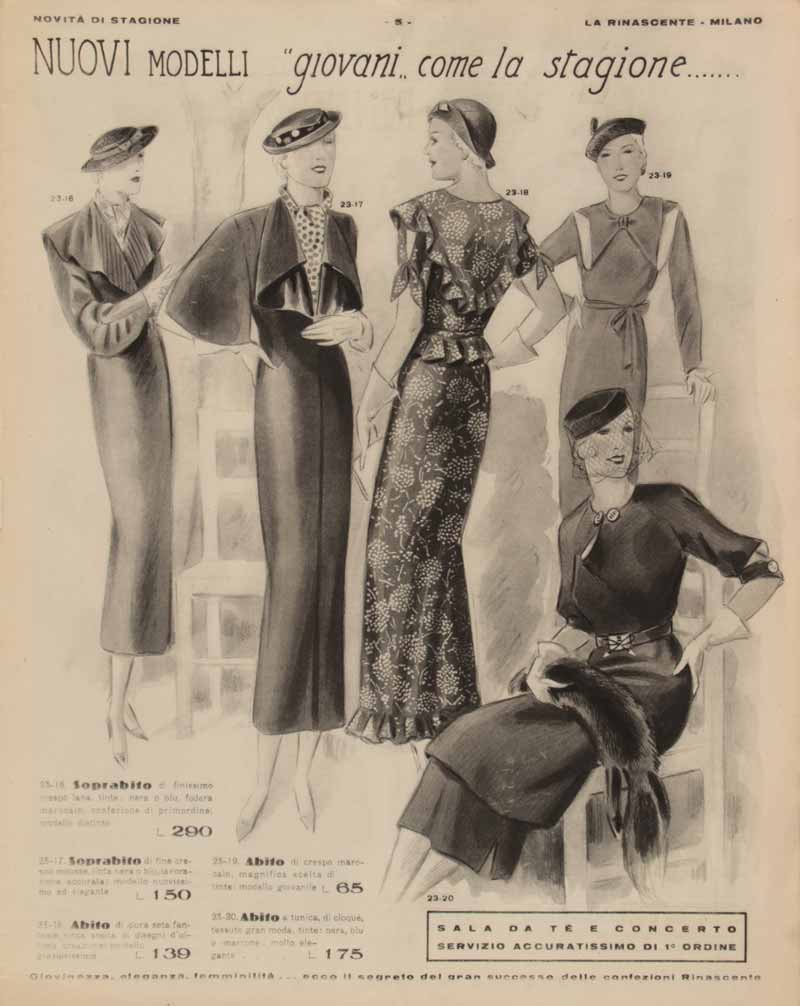
66 — Rinascente. Novità di stagione, listino mensile, a. XIII, n. 5, Milano, 25 marzo 1935, p. 5
Civica Raccolta delle Stampe Achille Bertarelli, Milano

67 — Rinascente per la spiaggia e la campagna, listino mensile, a. XIV, n. 13, Milano, 20 maggio 1936, quarta di copertina
Civica Raccolta delle Stampe Achille Bertarelli, Milano

68 — Rinascente per la spiaggia e la campagna, listino mensile, a. XIV, n. 13, Milano, 20 maggio 1936, quarta di copertina
Civica Raccolta delle Stampe Achille Bertarelli, Milano
The star of these illustrations was a very feminine silhouette, well-portrayed by Gino Boccasile with his famous ‘Signorina grandi firme’ (‘Miss Designer Brand’). The artist created not only posters for Rinascente, but also some drawings for the catalogues, like those published in the monthly brochure ‘Rinascente. Novità primaverili’ (‘Rinascente. Spring news’ of 15 March 1937.
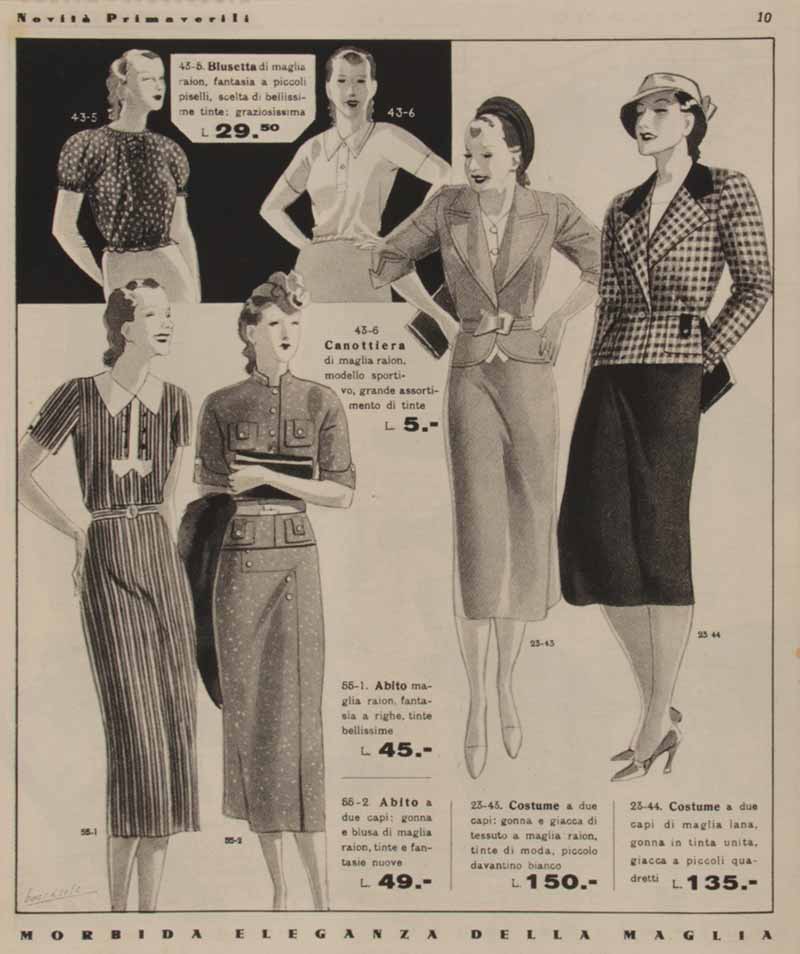
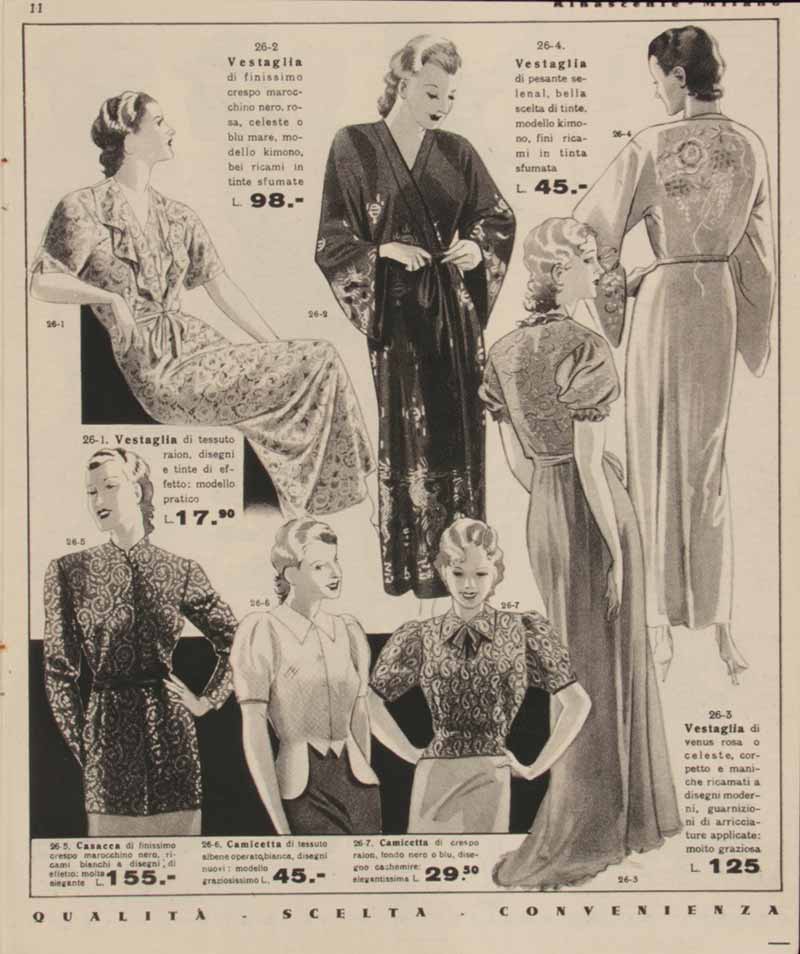
69 / 70 — Rinascente. Novità primaverili, listino mensile, a. XV, n. 4, Milano, 15 marzo 1937, pp. 10-11
Illustrazioni di Gino Boccasile
Civica Raccolta delle Stampe Achille Bertarelli, Milano
The need to document fashion as realistically as possible was met entirely by photography, which began to play an increasingly important role both in fashion magazines and the Rinascente catalogues where, from 1936, the first photos began to appear alongside illustrations, in perfect harmony.
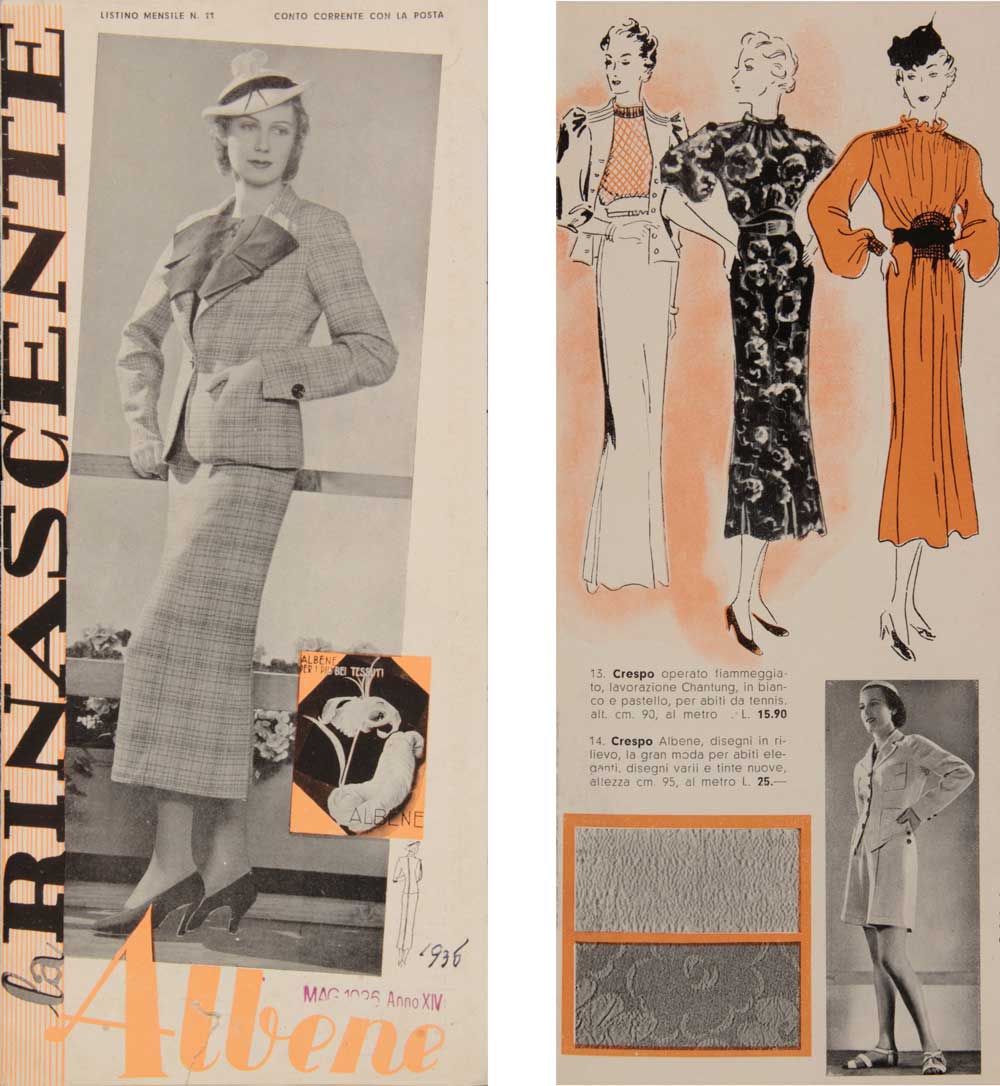
71 / 72 — la Rinascente. Albene, listino mensile, a. XIV, n. 11, Milano, maggio 1936, copertina e pagina interna
Civica Raccolta delle Stampe Achille Bertarelli, Milano
In the post-Second World War period, illustrations were almost completely replaced by photographs, including in the Rinascente fashion catalogues, deemed more suitable for showing customers the outfits on sale at the department store.